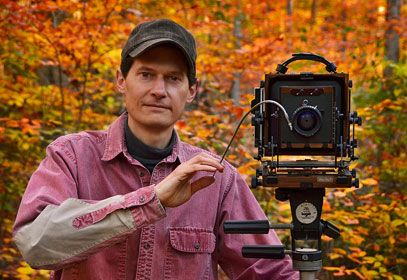Anniversary: Celebrating 10 years of Makeshift Darkroom
Posted Wednesday, January 1, 2020
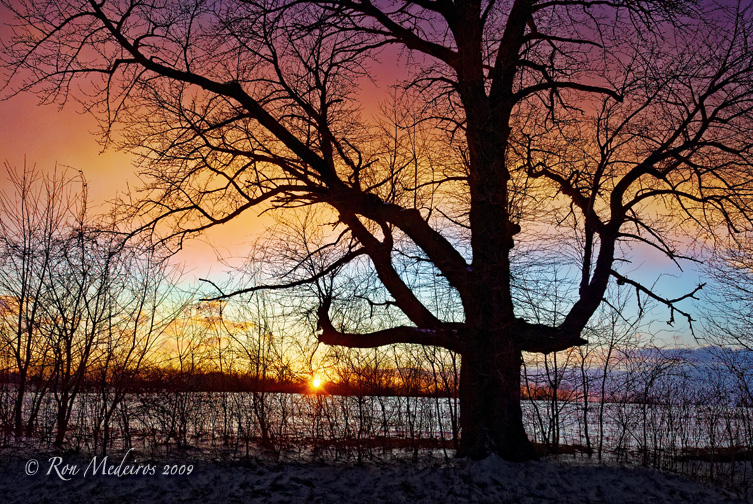
A Decade In Review
It's been 10 years since the launch of the Makeshift Darkroom website! The idea was conceived in 2008 and it took 2 years of planning and work to make it a reality in 2010. This Anniversary post features a selection of photographs chronicling my body of work going back to and beyond this past decade. This was a season of defining and establishing my photographic style in the still "new" medium of digital photography. This particular selection of photographs featured here are some favorite highlights of my larger body of work to date. Each of these images are special gifts that never would have been birthed and brought to light had they not been captured in the moment when opportunity favors a prepared eye. This post is a celebration, and serves also as a self-promotional piece filled with nostalgic vignettes of commentary concerning a life in photography. I invite you to join me for this look back. |
Makeshift Darkroom
The Photographic Domain of Ron Medeiros
Colors Optimized for Apple Monitors
Advertisement Free
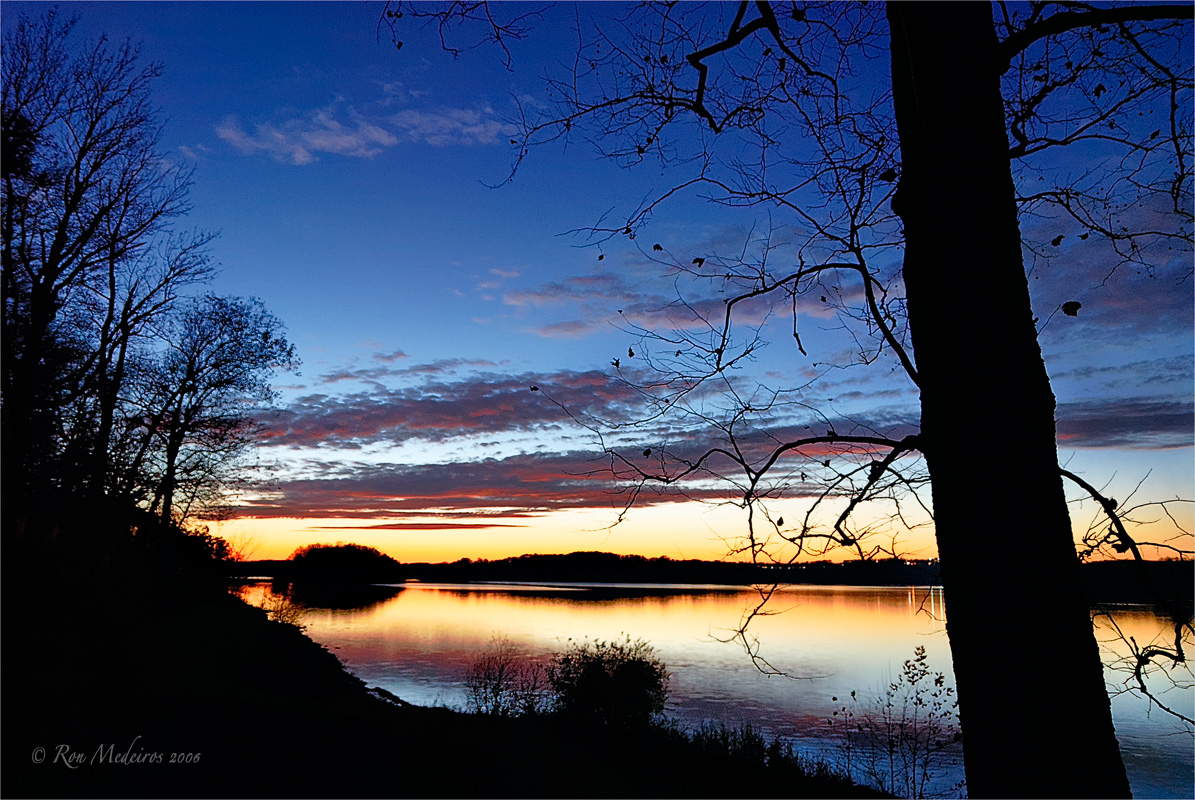
Sunset, Loch Raven
Nikon D200
18-200mm VR
"God made me to bring glory to His name, but he also made me creative like He is, and when I make photographs, I share with Him the pleasure of creating."
|
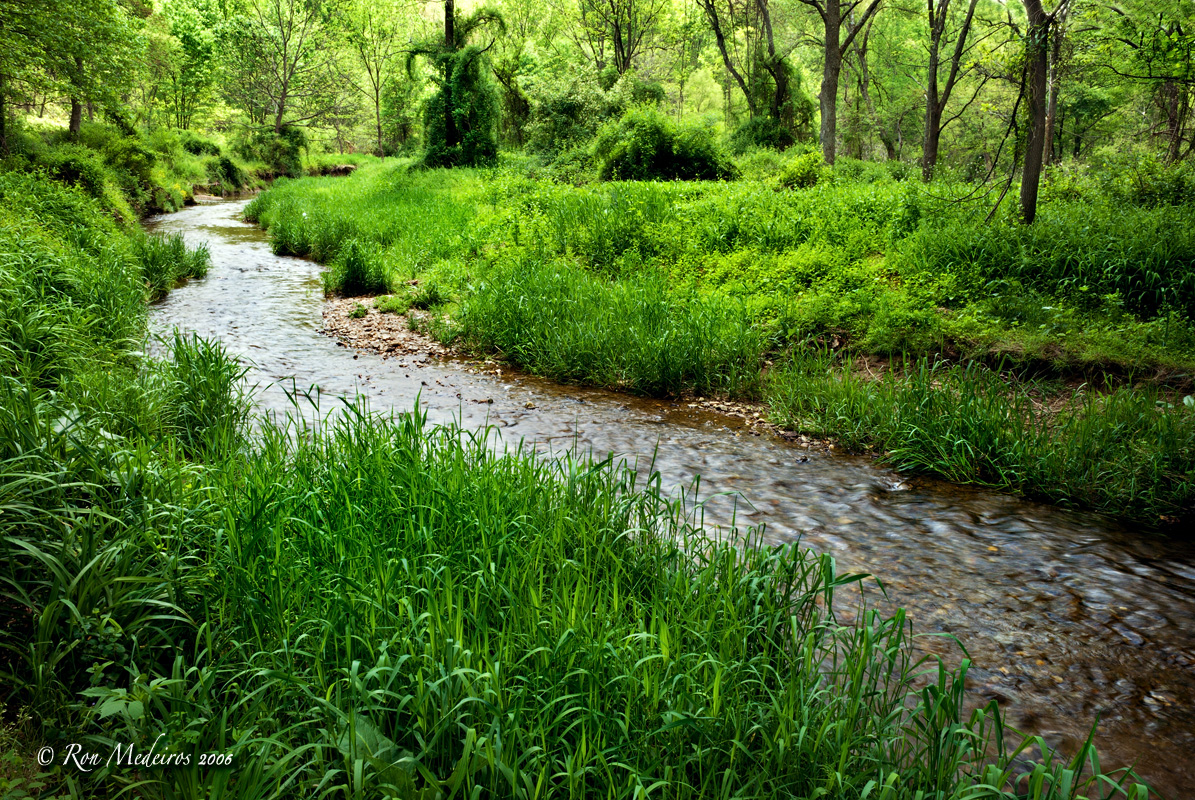
Where The River Goes
Nikon D200
18-70mm AF-S G
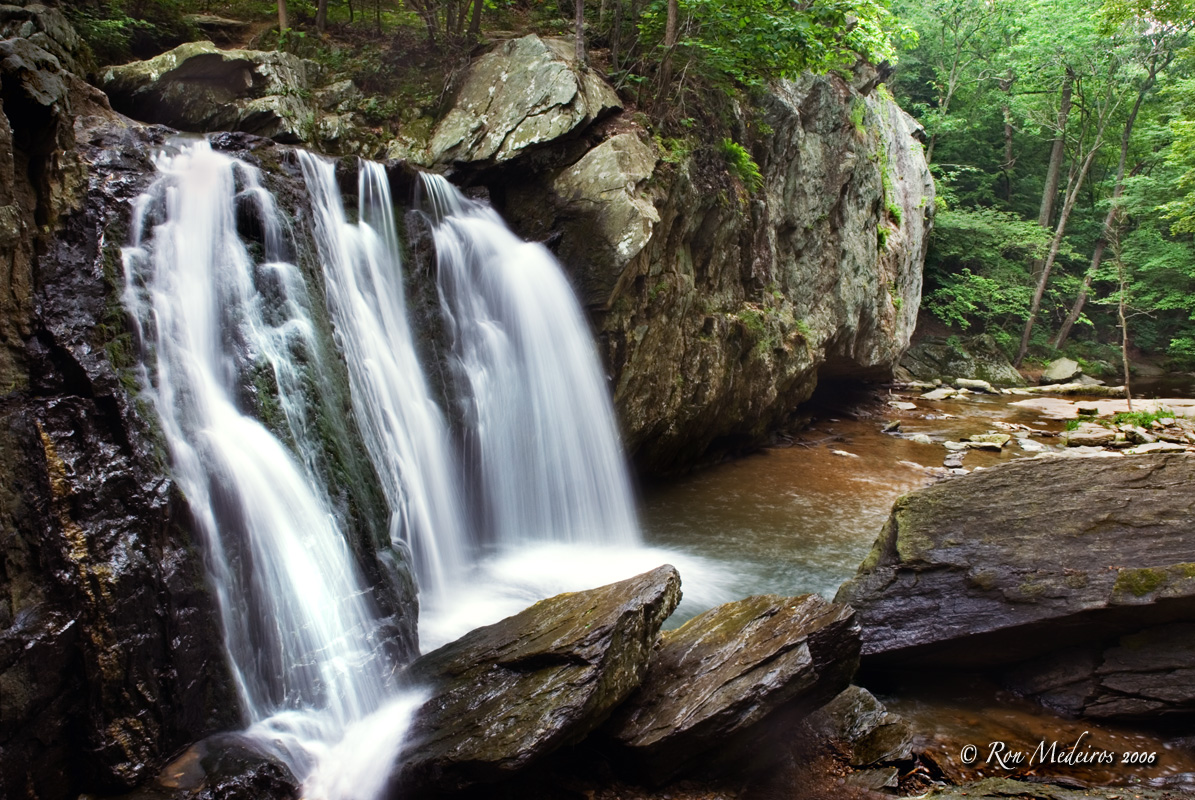
Kilgore's Colors
Nikon D200
18-200mm VR
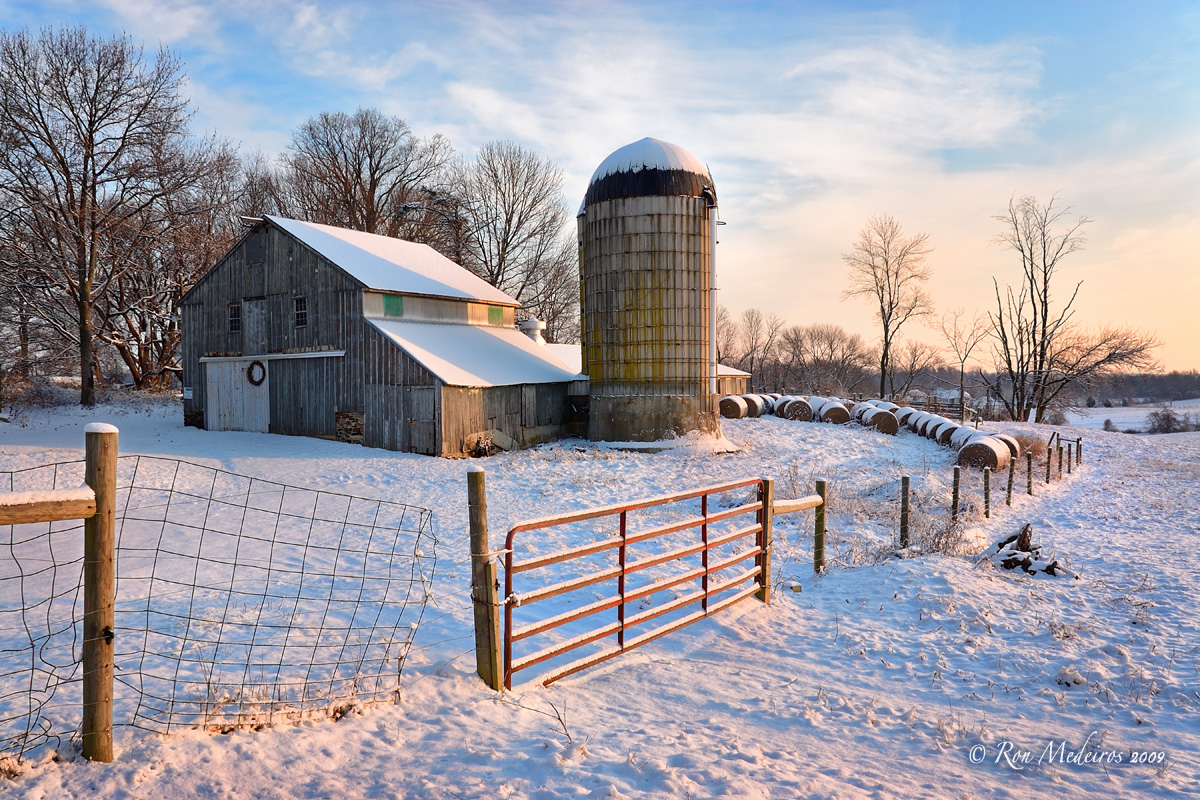
Barn, Winter Morning
Nikon D200
18-200mmVR
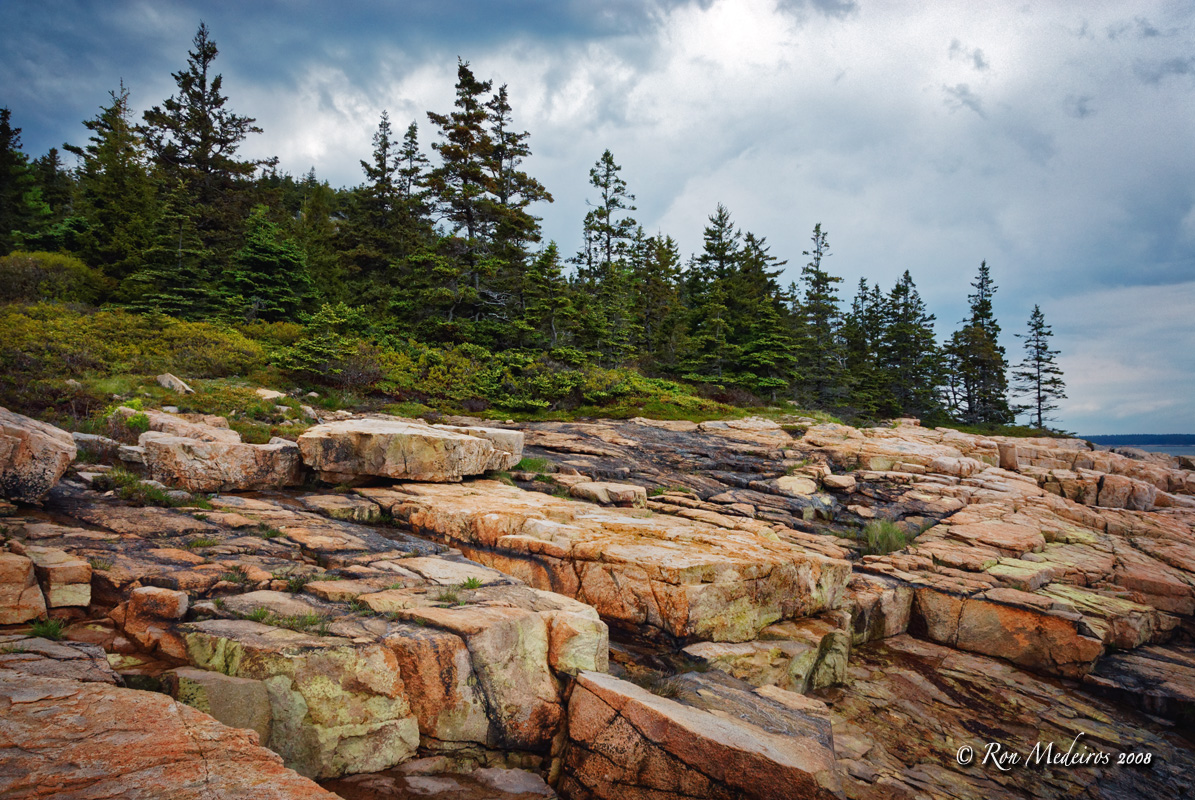
Granite And Conifers, Schoodic Peninsula
Nikon D200
18-200mm VR
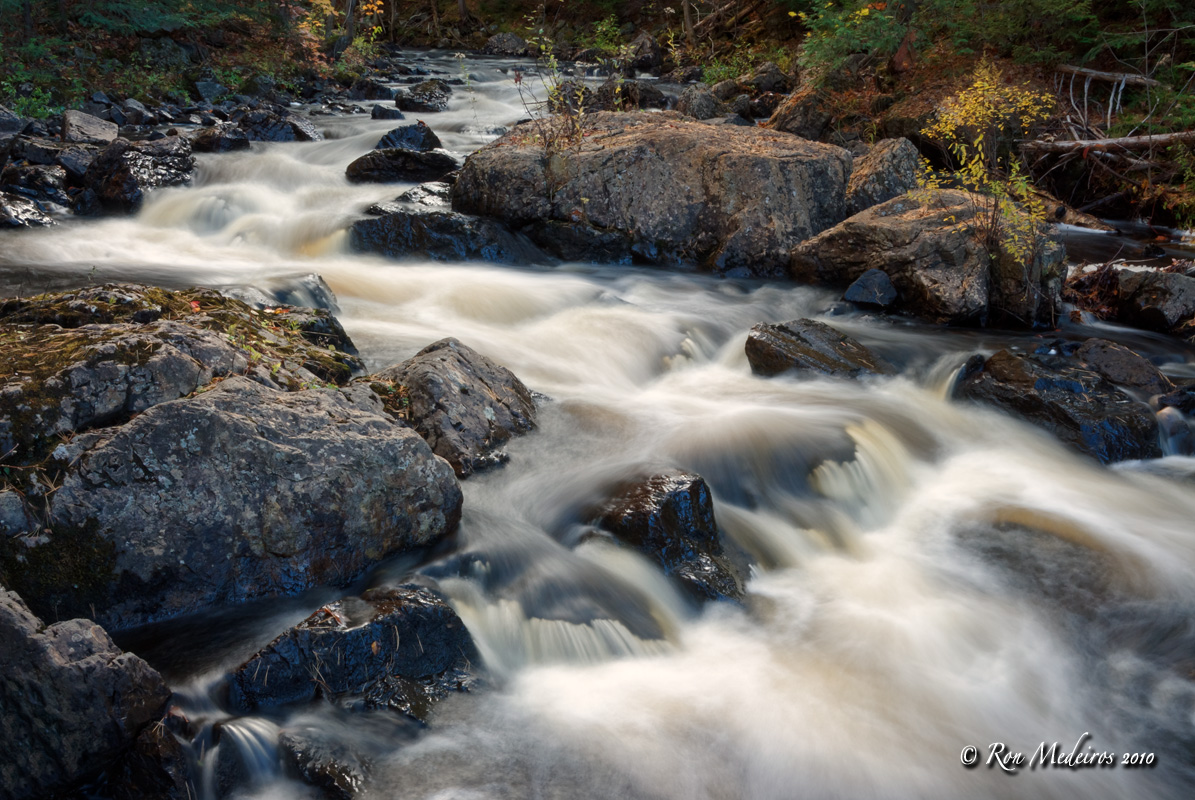
Silk Cascades
Nikon D200
18-200mm VR
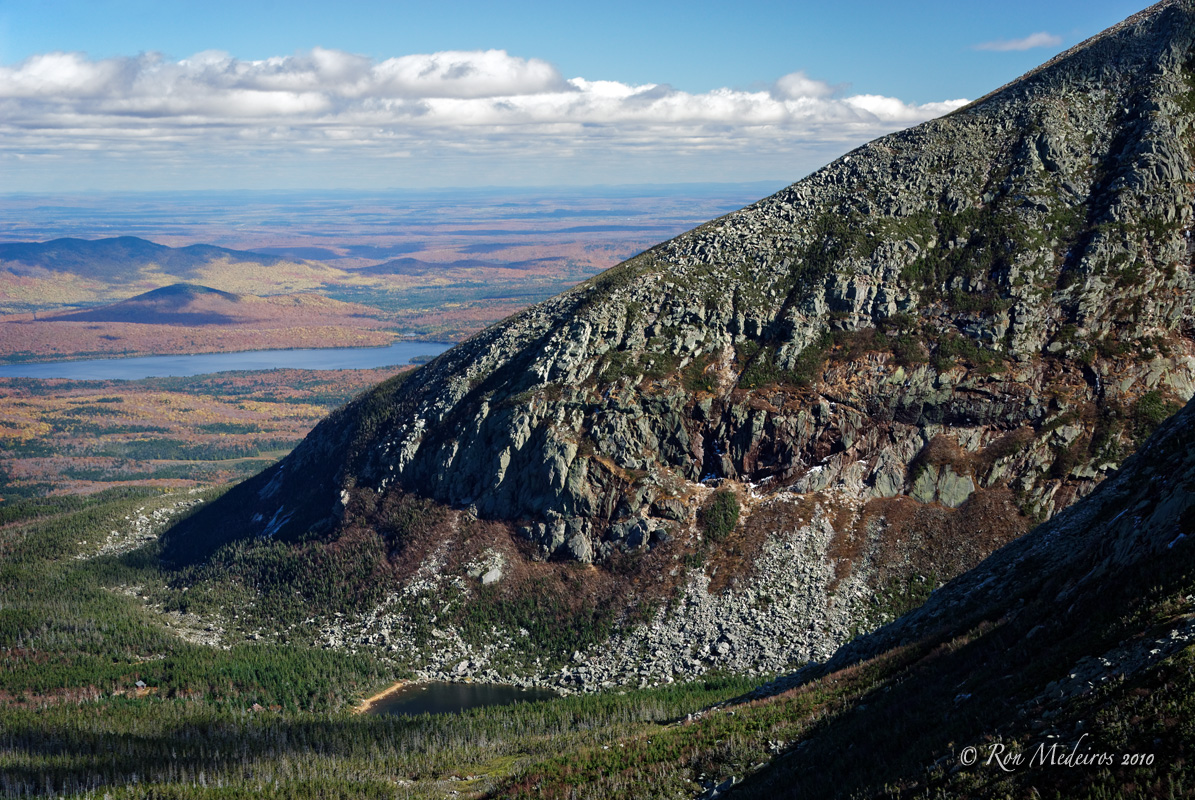
Colors Of Earth
Nikon D200
18-200mm VR
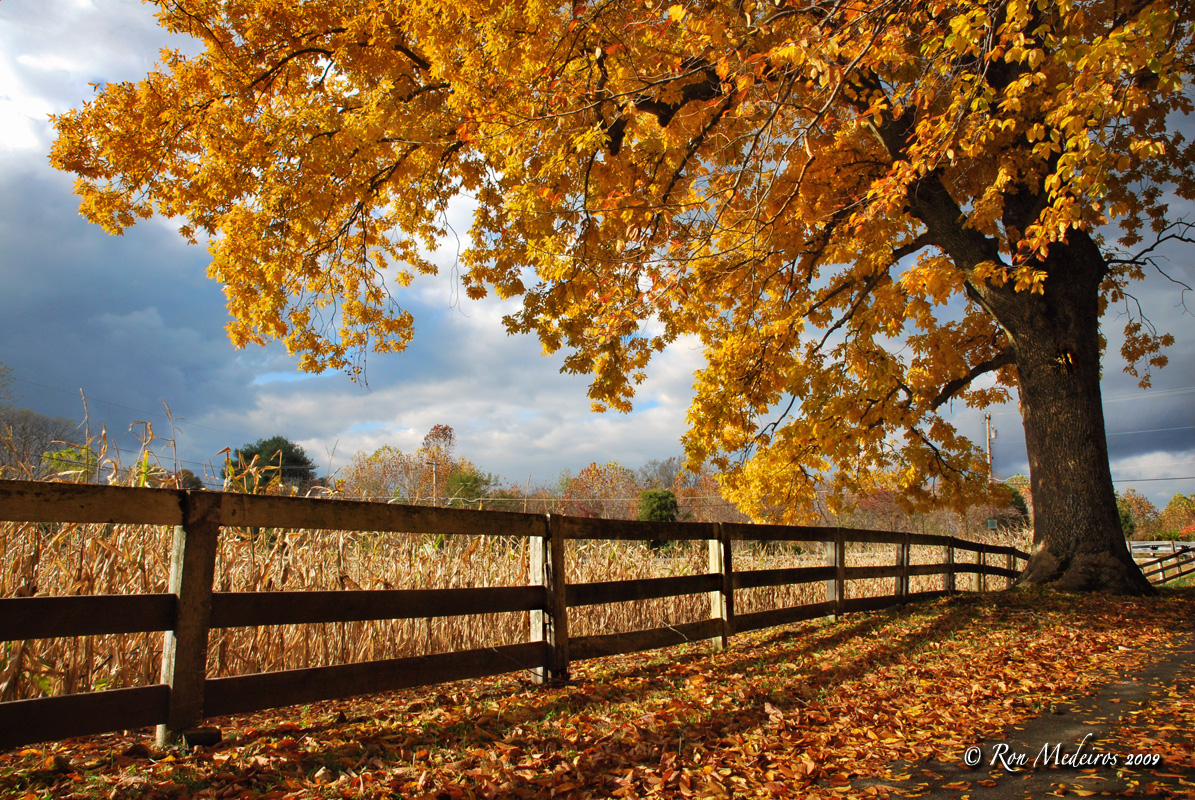
Golden Afternoon
Nikon D60
18-200mm VR
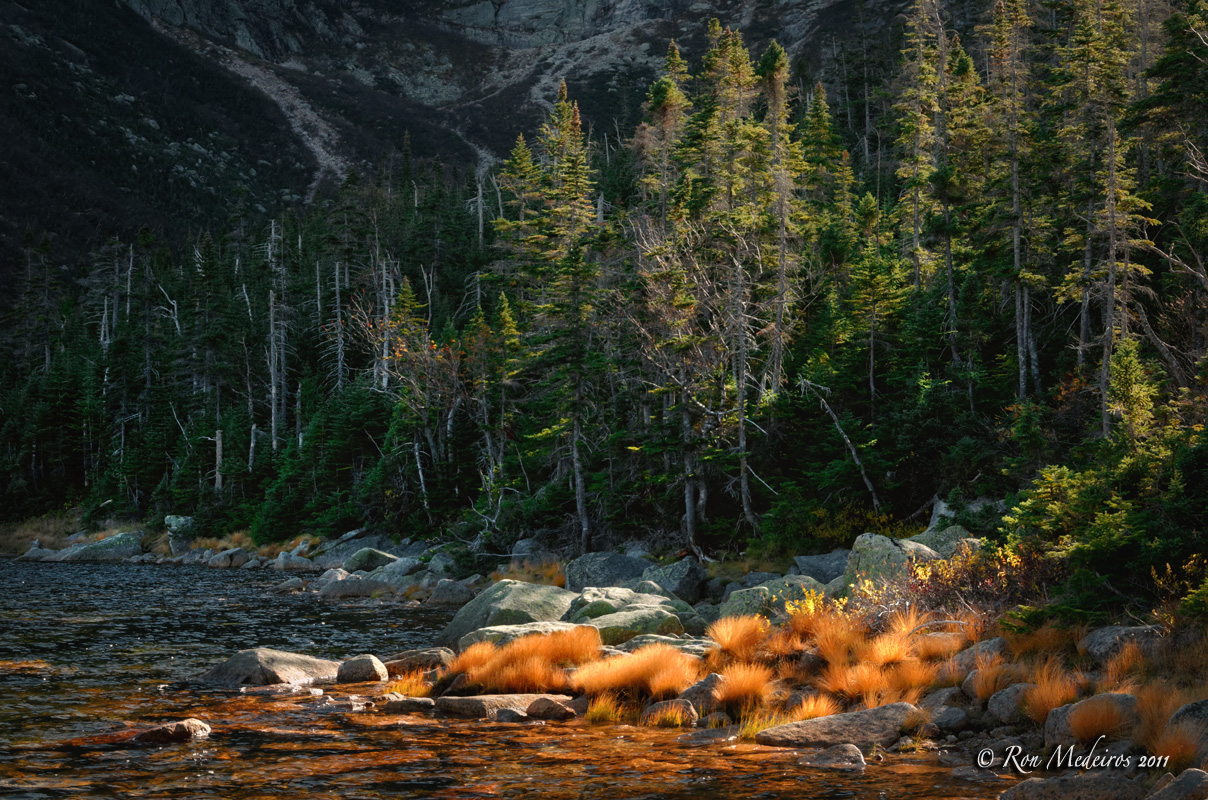
Fleeting Light, Chimney Pond
Nikon D7000
18-200mm VR
Color Photography
The following is spoken from a retrospective viewpoint for the purposes of sharing with you my life's journey through the medium of color photography. Present day, the term "color photography" is seen as kind of outdated since color photography has become elementary in this era of the electronic image. Not that long ago when film was the photographer's medium, working in color had a great many limitations and challenges.
To create high quality landscape images large and medium format cameras and film was necessary. Transparency film was the best option to get the truest colors, but what could you do with a medium format film transparency? You might project it for display, but that required a very expensive projector and the need to set up for a showing - not very convenient. You could print a cibachrome print if you could afford the expense of the paper and chemistry and if you had a color darkroom. Dust on prints from the transparency would print as black spots and could not effectively be spotted out. If you shot on negative film you could make color prints but optimum results were only possible if you had a good print processor like a Kreonite machine. Kreonite processors were professional lab machines and were very expensive to purchase and to operate. The RA-4 printing process was very temperature critical requiring tolerances of + or - 1/2 of a degree Fahrenheit for optimum colors. So for most people this was out of reach. This is one of the reasons why photographers were forced to rely on "color labs" to process their work for them. Ansel Adams, who preferred to do his own photo finishing, chose to work in black and white stating that color photography, "lacked certain controls." I once considered 8X10 large format transparencies which could be displayed by backlighting them, but there was no way to edit or enhance the photograph as everything would be done "in camera." I am not an in camera photographer, nor could I afford sheet film costing, at the time, $10 per sheet plus processing, plus the cost of a Polaroid test shot to determine the exact exposure needed.
My preferred way of doing color photography back in the day would have been to shoot medium and large format color negative film and make enlarged Kodak Duratrans or print film transparencies. These were a negative to positive transparency film that was then printed in the enlarger with dodging and burning just like a paper print. It was processed with the same RA-4 process in the Kreonite processor and the resulting transparency could be backlit for display (imagine the impact of a 11X14 or 16X20 transparency). This process was also expensive and out of my reach for all of the afore mentioned reasons. At the beginning of the digital era when the sun was setting on these film processes, film scanning was in it's infancy and was not readily available or affordable to amateur photographers. I opted instead for the medium of black and white photography for my creative work which was both affordable and practical though in certain instances disappointingly devoid of glorious living color.
The electronic image solved all of these problems and removed all of these limitations. Medium and large format image quality can now be approached from a small light weight 35mm style digital camera with a landscape friendly 3:2 aspect ratio format. Resulting images can be digitally processed for immediate viewing on screen and online without ridiculously expensive silver based materials, and critical time consuming chemical processes. Digital capture is worlds "cleaner" than analog silver emulsion film images. Pixels are perfect where silver emulsion is randomly imperfect with color casts and film base fog. The retro look of film is still desirable for some photographic genres, but for highest quality applications like landscape photography digital is supreme due to it's image quality and removes all of the limitations that hindered photographers in color photography of the past.
With the era of the internet, electronic viewing of photographs is not only easy and immediate, but is perhaps the best way to exhibit images. Today's apple monitors represent color and contrast even better than backlit transparencies of the past. Transmission display is superior to reflective display which is why "chromes" have much more contrast and pop than prints. Monitors are now the optimum gallery, enabling anyone to see a photographers work instantly most anywhere in the world. These days I don't make very many prints; instead, I prefer to view my work on a desktop Apple monitor. I refer to this as my electronic portfolio (e-portfolio) having all of the vivid color and contrast of backlit transparencies. Prints take up space, have to be stored, are easily damaged, and are subject to decay. Virtual images need only be backed up on and off site and they (consisting of data) are not directly effected by decay and remain ever available to be printed afresh as needed. |
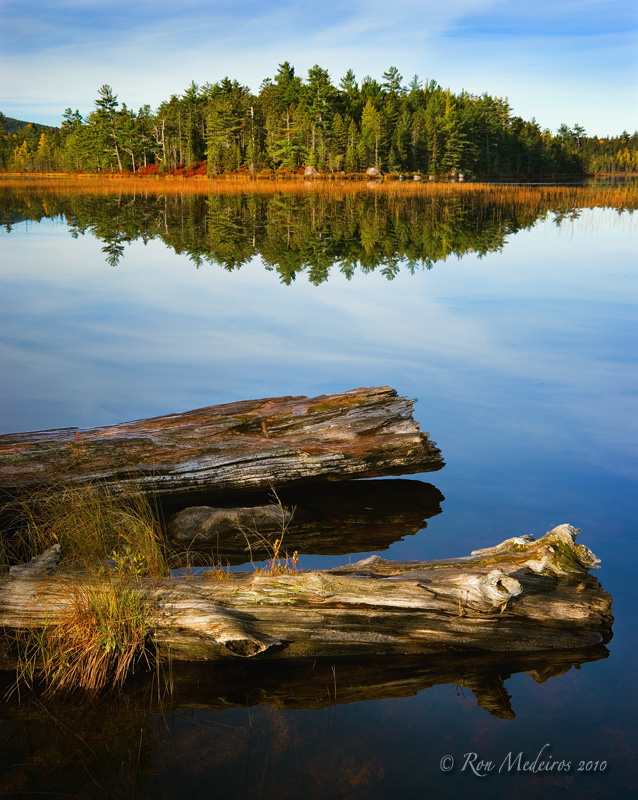
Stillness, Elbow Pond
Nikon D200
18-200mm VR
Procedure and Style
I use today's digital technology in a minimalist fashion. I do not use it to create surreal or synthesized computer generated images of something that did not exist at capture; instead I use it as a means to simply accomplish what I always wanted to do, but could not afford to do with the color materials of the past. Practically speaking, I use post-processing to simply remove from my images the limitations of the camera until I have achieved the picture that I envisioned at capture.
My most valuable skill as a photographer is not my working knowledge of cameras settings or expertise with the latest post-processing software, but it is having the eye to see how my photographs should be rendered in their final finished state.
The image above, "Stillness, Elbow Pond" looks as if it were shot on transparency film with a large format camera. It is not surreal, overdone, or too good to be true; it looks like a "real" photograph. I use the most basic post-processing techniques to render images the way I would have rendered them if I had had the full resources of yesterday's color darkroom at my disposal. I apply the same degree of creative control in working with color as I did in the wet black and white darkroom.
Some "photographers" take post-production beyond its definition and, like Hollywood CGI artists, "build" images in the computer rather than to merely enhance and refine what was captured with the camera. This is not photography in the truest sense; it is computer generated imaging, even if it utilizes photographic stock in the process. I do not composite images to replace skies, back grounds, or foregrounds from different photographs captured at different locations, or different times of day to create an image that does not exist anywhere in reality or is "too good" to be true. In other words, my work is "real" photography and not "digital wizardry." Though much of my work is done in post-production, I am a photographer not a Photoshop artist. I'm sure you understand the difference.
My style is traditional or real photography with an emphasis on artistic and technical quality. My photographs are characterized by good dynamic range, a full range of tonal values, rich velvety colors, and realism. My intent is to render the world and my subject matter not so much exactly as it is, (that would be documentation) but as it should be or how I prefer it to be. In photographing the natural landscape I present it as pristine and untouched by man. The hand of mankind is almost always absent from it as though mankind's influence would keep it from being a pure representation of God's creative work. The earth is under the curse, but not because the earth is in itself evil, it is cursed because of man's sin and so I keep the source of sin (man) out of it.
The pictures that a photographer makes point back to the photographer and reveal something about what kind of person he is. His character, or lack thereof, will be reflected in the pictures he makes, and his choice of subject matter.
I photograph people with a documentary style that isn't truly documentary. True human documentary work records people as they are - it documents what is. I, on the other hand, generally (but not always) portray people as I prefer to see them, as I believe that they should be - at their clean best. In doing so I remove from my photography all that is undesirable in the human condition to reflect my own personal values, and to preserve the beauty and dignity for which man was originally created. My basic objective in photographing people, is to make the best and most photographically appealing images of people in their element or environment, and not so much to express who they really are off camera. For me, it is about the artistic quality of the photograph itself. It is all about the photography.
I don't use my camera to promote some environmentalist, social, or humanitarian cause. Many photographers who are trying to find meaning for their life often adopt some such cause because they want to matter and "make a difference." But I have already found the meaning of life and purpose in my Christian faith, and there is absolutely nothing that is higher or more important than that. Christianity is the thing that best improves and changes the world.
Another aspect of my "style" as a photographer is that I tend to resist change and to remain largely unmoved by all of the rapidly shifting and fleeting trends in contemporary photography. I have no desire to be another one of the thousands who chase the trends, but to establish my own standard. Though I am aware of the current trends of popular photography, and continue to learn and explore new ideas, I am resolved to maintain my own style. My style is as unique as my own signature, and with it I am determined to make my mark upon the world of photography wether it is acknowledged or not. |
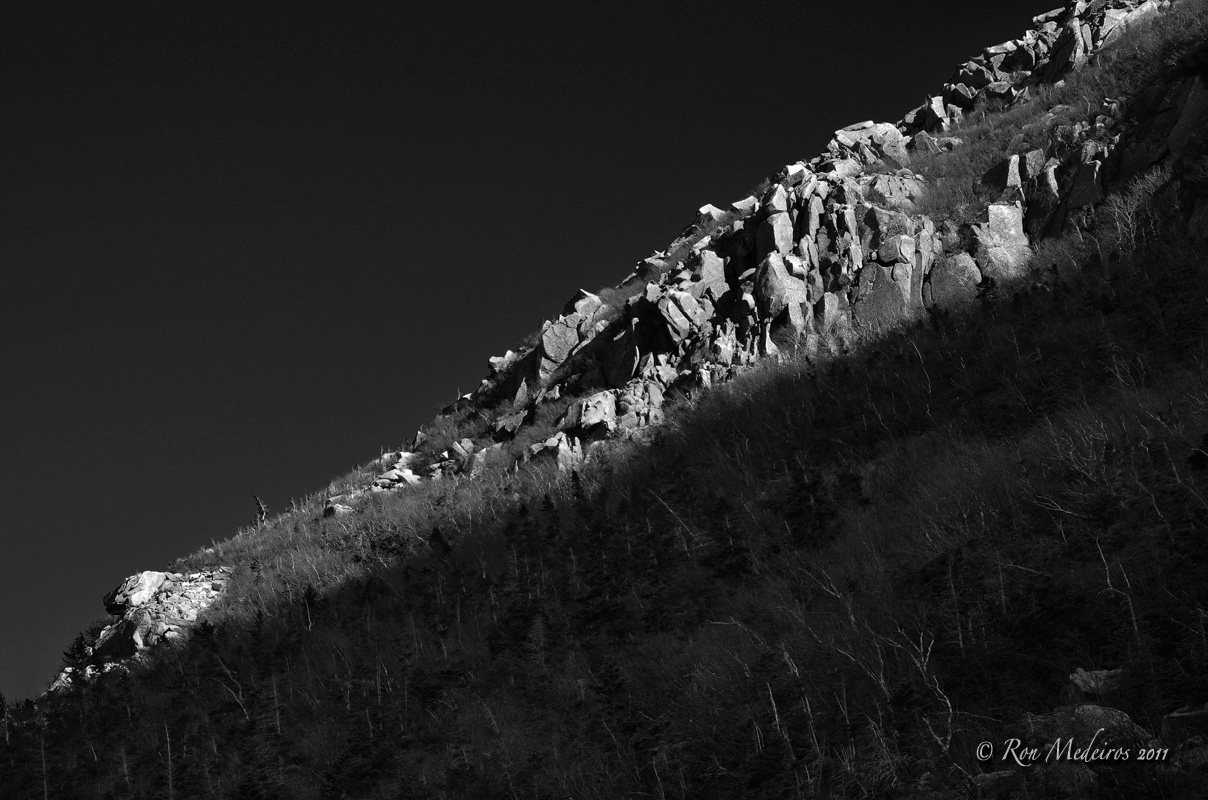
Slice Of Light
Nikon D7000
18-200mm VR
Remembering Ms. Pardee
In my teenage years, back when I was beginning to print my own negatives in the darkroom, I made the acquaintance of an elderly woman named Ms. Pardee. She was the grandmother of a friend of mine that we had gone to visit one afternoon. During that visit, the conversation turned to photography and she was delighted to hear that I was experimenting with the black and white darkroom. She told me that she had worked for Ansco (a manufacturer of cameras and photographic materials) for many years and she too had a considerable interest in photography. After further talk she really took a liking to me as I did her. We really hit it off as kindred spirits who enjoyed each others conversation. She decided to pass on all of her darkroom equipment to me. She gave me her glass Kodak beakers (now antiques), print trays and tongs, enlarging easel, tank and reel, film clips, apron and other sundries (some of which I still own and use today). But most of all, she encouraged and inspired me in photography. To me, she was a living link to the earlier days of photography that predated my own experiences with the medium. Her stories of the products and techniques of her era overlapped with that of Ansel Adams who would soon become my biggest inspiration. Many young photographers of this latest generation have probably never even heard of companies like Ansco / Agfa or Edwal whose products were a regular part of Ansel's early work. Ms. Pardee's enthusiasm fanned the spark of my own enthusiasm in my early days of photography which still burns as a flame today. The memory of her kind friendship remains pleasantly nostalgic and will always be a part of my photographic heritage.
|
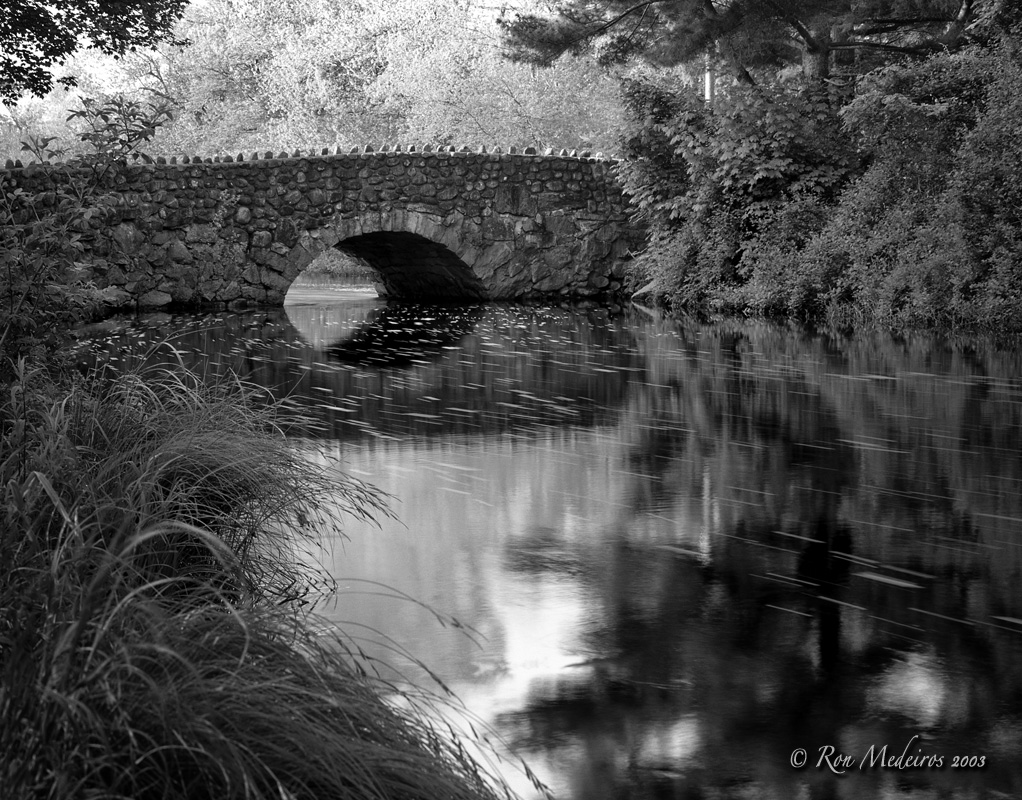
Arch Bridge
Bronica GS-1
100mm f 3.5 Zenzanon PG
Kodak Tmax 100
Developed 6 1/2 minutes in Kodak D-76 stock solution
Printed on Agfa Multicontrast Classic 111 FB Glossy
Print developed for 2 minutes in Kodak Dektol 1:2
Lightly toned in selenium for archival permanence.
The Art Of Black And White
Unless you have had the experience of shooting and developing black and white film and making prints from your negatives in the darkroom it will be quite difficult for you to appreciate what it takes to successfully achieve a fine photographic print. And it will be equally difficult for you to comprehend the uniqueness of the black and white medium itself and its creative potential for beauty. The print above entitled "Arch Bridge," like many other prints I have made, required the better part of a day to achieve the fine print. The art of making a print is an endeavor to render a complete tonal range of grey values, from deep rich blacks to pure white, from the less than ideal range of information on the negative. Not only must the photographer know how to control the values of grey on the print in terms of procedure, but he must also know what those values should be according to what he intends the final print to be. This is one of the great challenges of black and white photography.
Color more often steals the show, but there are many pictures that cry out to be rendered only in monochrome, and the skill lies in seeing which pictures belong to that world and how to render them accordingly. Black and white photography is in it's own category and quite a different thing than working with color. I often find myself torn between the two which is why I am resolved to work with both. The fact that they are both so different leaves me the richer enjoying a more diverse experience.
Many people mistakenly understand black and white to be the absence of color, while connoisseurs of black and white photography understand it to be the demonstration of tonal values without any regards for color. Successful black and white photography should make the viewer forget about color and feeling no need of it. It could be said that a black and white photograph fails when it leaves the beholder in want of color.
As an art form, black and white photography continues to live on in the ones who, through experience and love understand it's mood, drama, and artistic qualities. It is something that is hard to put into words, but is Instead "felt" by those who have experienced that world and have learned to communicate in its language.
|
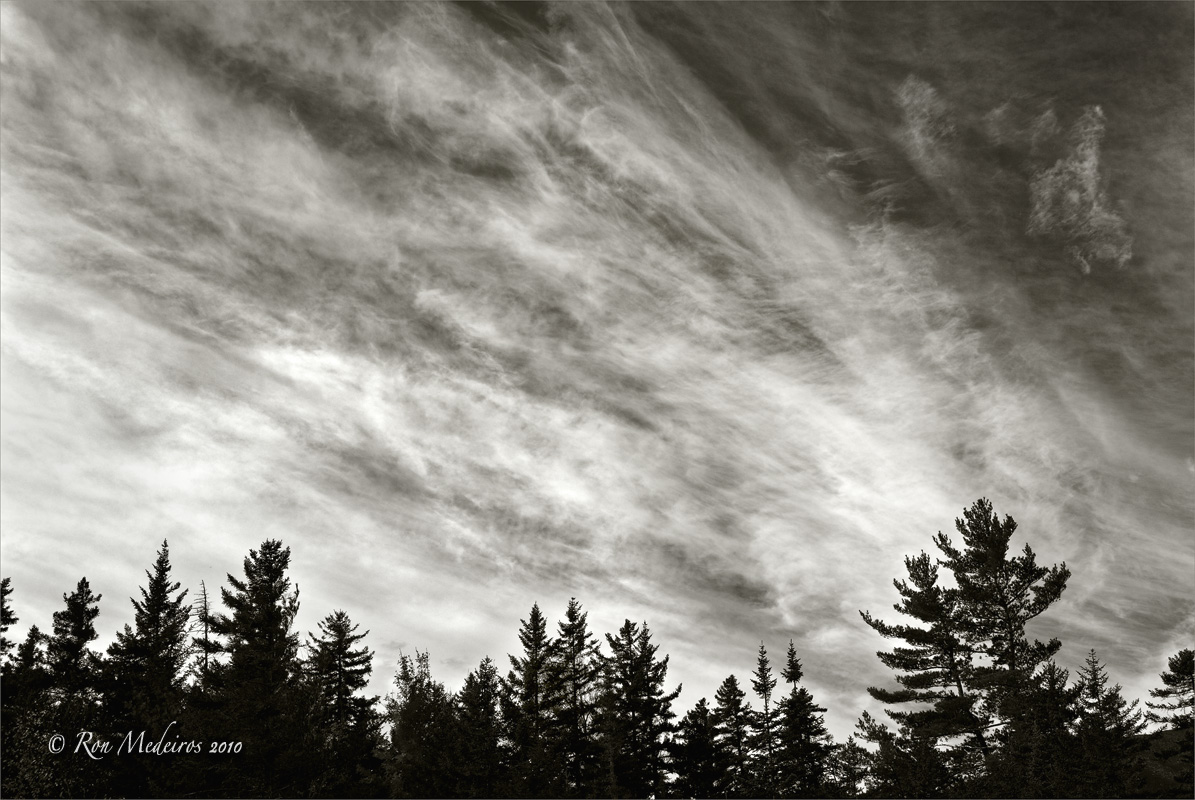
Sky And Treetops
Nikon D200
18-200mm VR
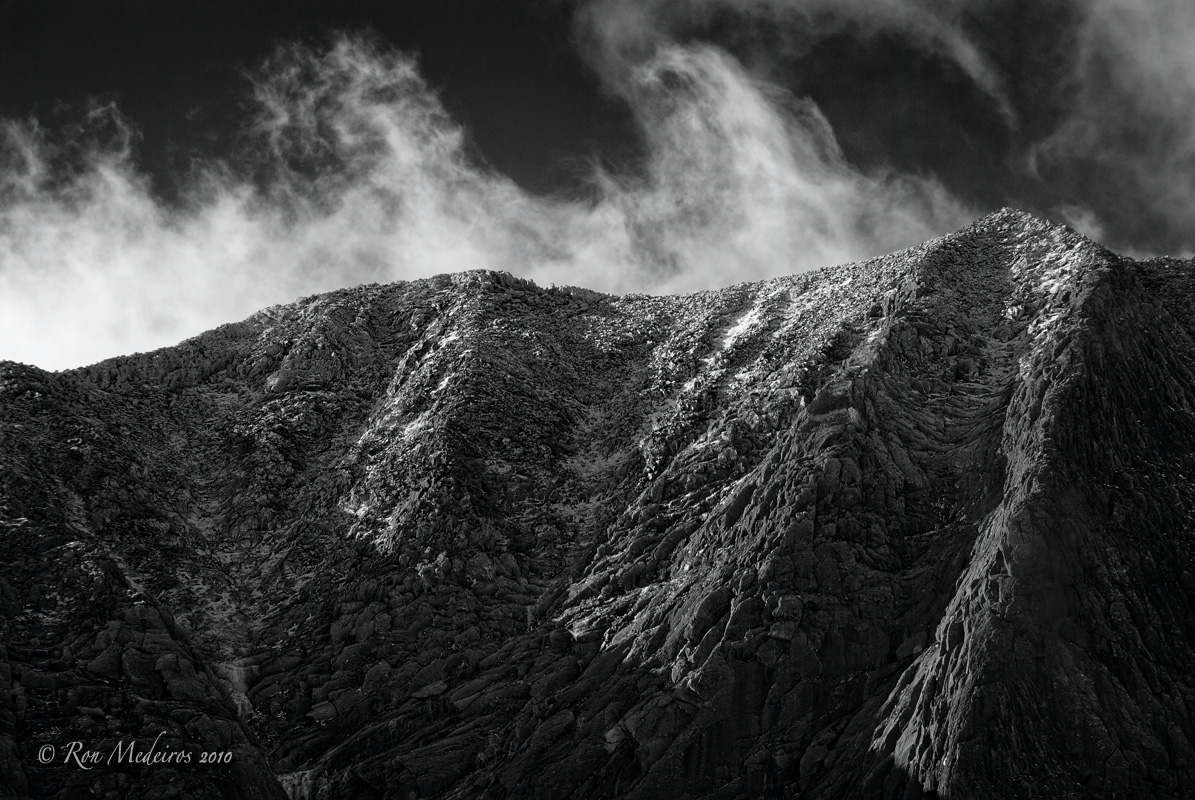
South Peak, Mount Katahdin
Nikon D200
18-200mm VR

El Capitan
Bronica GS-1
100mm f 3.5 Zenzanon PG
Ilford FP4 Plus
Developed for 8 minutes in Kodak Xtol stock solution
Printed on Agfa Multicontrast Classic 111 FB Glossy
Print developed for 2 minutes in Kodak Dektol 1:2
Lightly toned in selenium for archival permanence.
A Throwback To Film
Having stated above the many benefits of digital photography and it's use in landscape photography I must also say that I have by no means abandoned the use of film and film cameras in my work as a photographer. As a throwback, I have a very strong nostalgic bond and love for traditional photography and the medium of film and "real" film cameras. I particularly like shooting film for much of my human documentary work, among other things. There is also a place in my heart for shooting medium format black and white film and even occasional color transparency film for certain landscape images now that in home film scanning is easy for anyone. There is nothing as enjoyable to me as working up a good film scan into a beautiful photograph and adding it to my portfolio.
One of my most recent practices that I am experimenting with is what I call, for lack of a better term, "hybrid processing" which is to shoot and develop analog film images the traditional way and to then scan and edit the resulting digital files in a manner that preserves the film "look." This hybrid approach gives me a best of both worlds result and yields a film image aesthetic with the post-production control of the digital darkroom.
The random grain structure of film is preserved and yields photographs that look like film images of the past yet with improved dynamic range, tonal, and color rendering. After images are scanned, cleaning up and editing out dust and unwanted distracting elements within the image are possible. One of the benefits of shooting black and white panchromatic film is that it renders colors as values of grey differently and more pleasing than digital cameras do. This gives film images their own distinctive look that I am used to seeing from back in the day. Sometimes digital camera images rendered in black and white can look great. I have often found however, more times than not digital images in black and white are disappointing, looking too clean (digital) and with a less than desirable tonal rendering of the original colors. With scanning film the characteristics of film are preserved in the files making it a better option than trying to "simulate" a film look in digital camera files with film simulating software (which is rarely accurate). These differences are subtle but noticeable, especially to a trained eye.
Film technology remains at it's pinnacle and the added benefit of hybrid processing makes film even better. For example, the last and greatest iteration of Kodak's Tri X film utilizes a blend of traditional cubic grain as well as the newer Tmax T-grain emulsion technology that has greatly improved and minimized the course grain of the older versions of Tri X. Today shooting Tri X and developing it in Kodak Xtol developer yields a beautifully fine but well defined grain similar to plus X of the past. It is like shooting Kodak Plus X only with a higher native speed of ISO 400 with the added option of pushing it a stop or two.
Of course the added benefit to hybrid processing is that I get to shoot with my old film cameras of the past (real cameras, not computers with lenses that go obsolete and have to be replaced as tech improves). I don't mind telling you that of late I find myself gripped by the desire to go back to my Nikon F series cameras and the traditional medium of film for certain genres of work. Real film cameras are uniquely different from today's digital wonders. It remains true that you can do more with digital cameras, but it is a very different experience than an analog film camera, especially to throwbacks like myself. For pure shooting fun give me my F3 with a motor drive and a roll of Kodak Tri X.
|
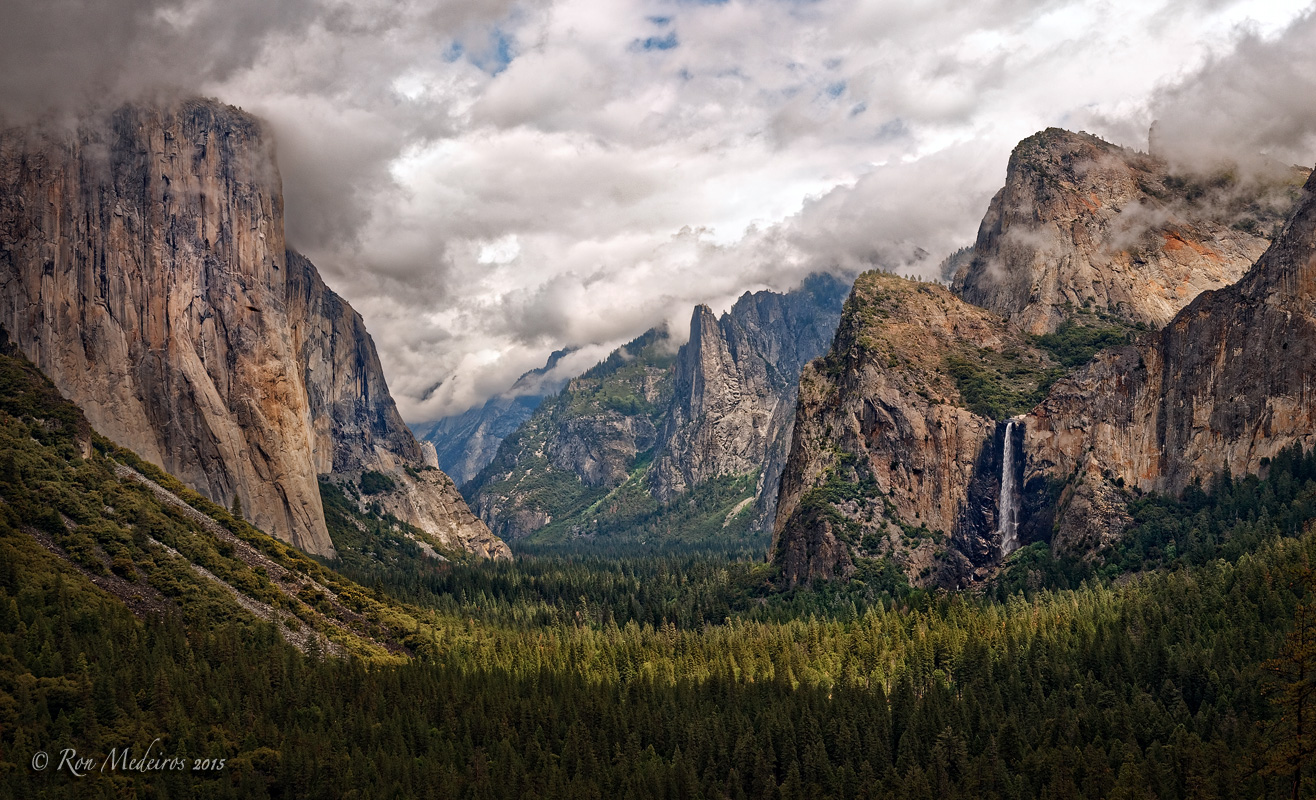
Yosemite Valley, Springtime
Nikon D7000
16-85mm VR
Early Inspiration
While browsing a bookstore in 1982 I discovered a book entitled, "The Portfolios of Ansel Adams." I remember being stunned by the quality of his photographs and immediately became aware of just how bad my photographs were. At the same time I was instantly inspired to raise the bar with regards to composition and print quality. Many photographers have been inspired and influenced by earlier photographers, and for me it was Ansel Adams. His photographic style really struck a chord with me and helped define my direction in photography. Over the years I have developed my own style, but much of my work today still reflects this early influence.
With a resume of photographic experience spanning more than four decades I am a throwback from an earlier era of photography. I have learned from masters of photography and was schooled in the days of photography's golden era when Kodak was King and when film, paper, and chemistry were the sole medium of creativity. Melding this background with the latest advances of the era of digital photography makes my work unique among this present generation of photographers.
|
" Perhaps the most important characteristic of my work is what may be called Print Quality"
- Ansel Adams
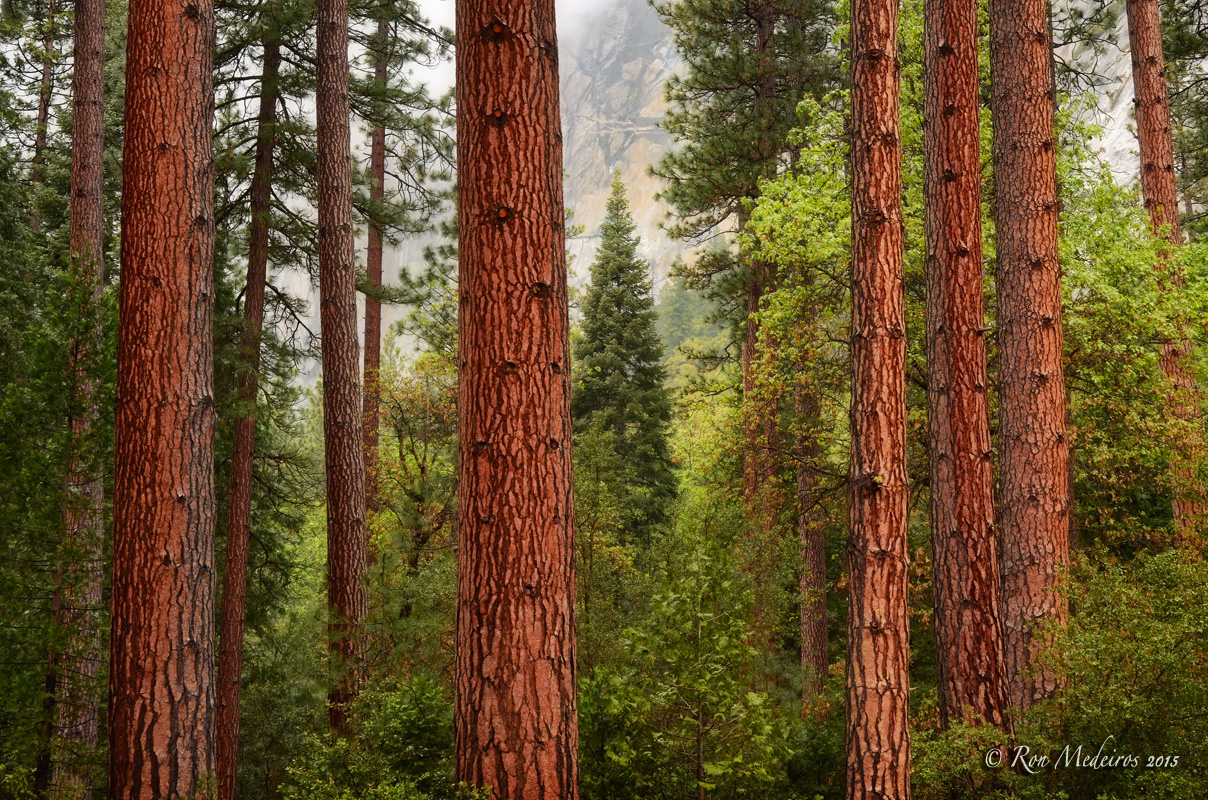
Yosemite Forest
Nikon D7000
16-85mm VR
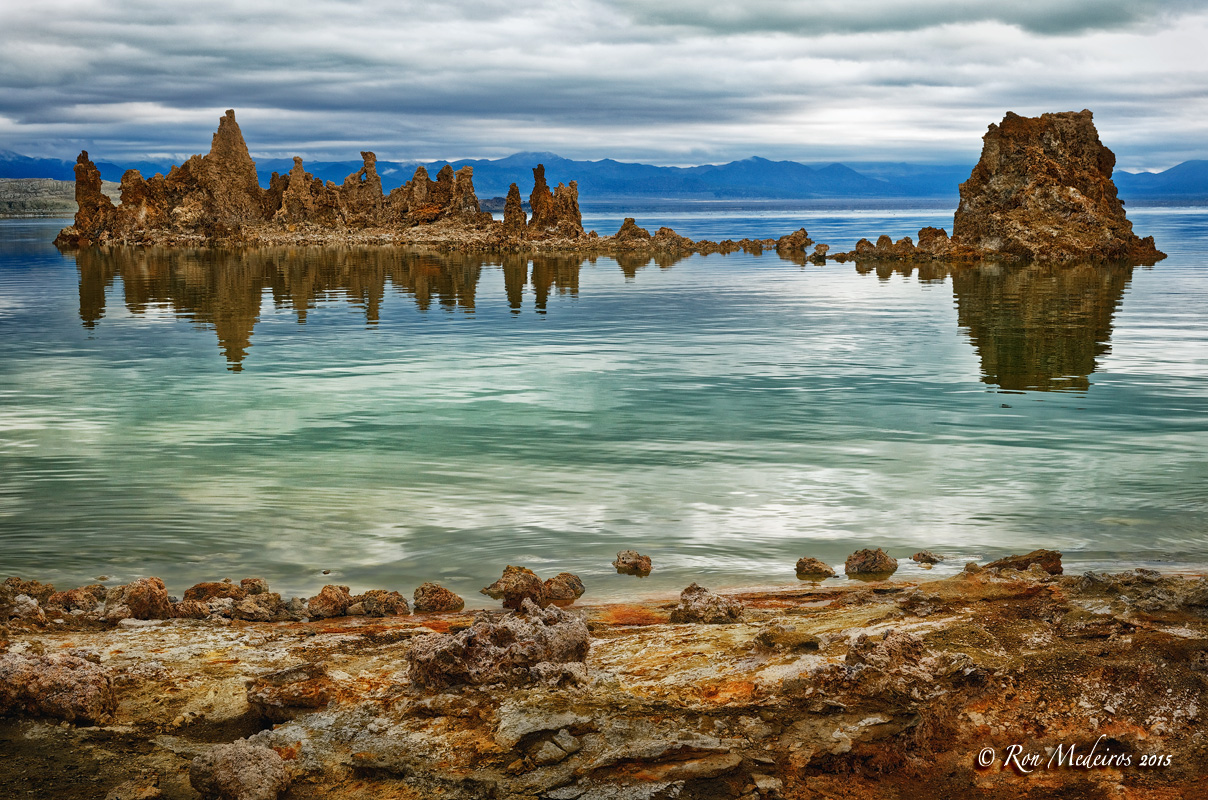
Mono Lake
Nikon D7000
16-85mm VR
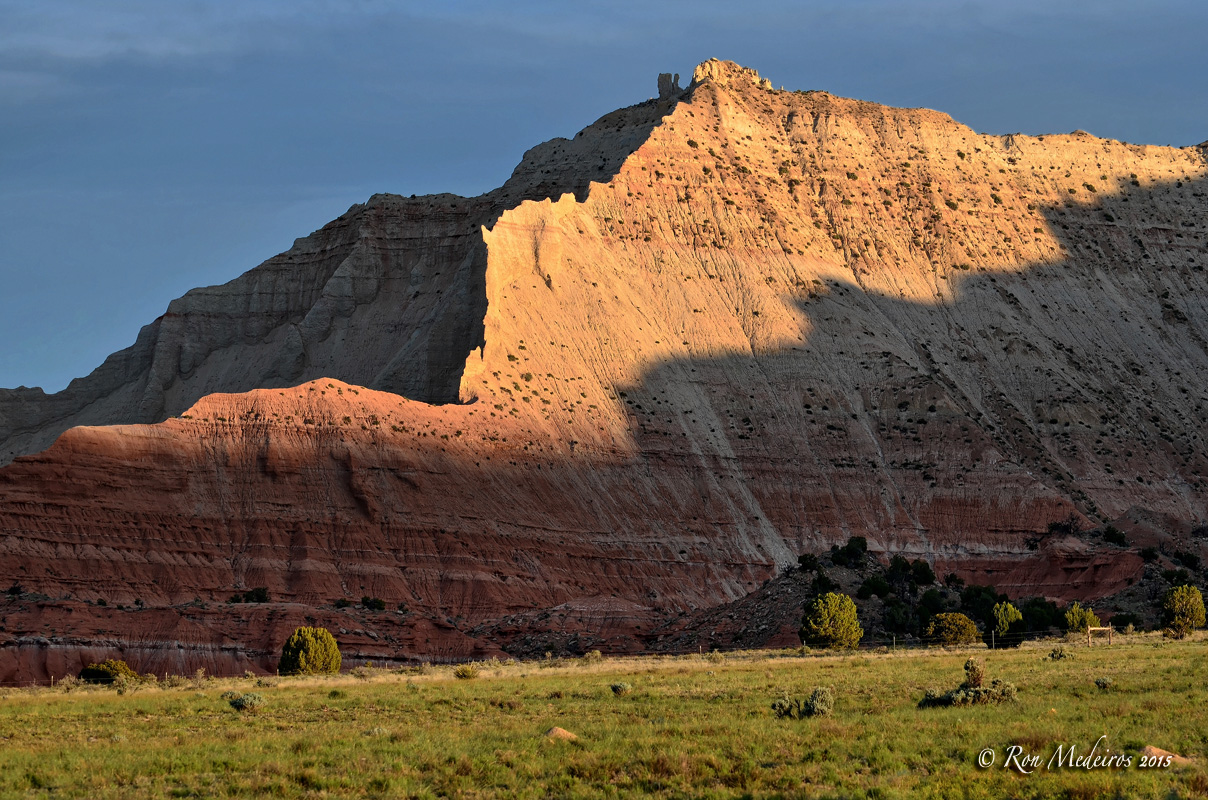
Kodachrome Basin Frame 3
Kodachrome Regret
We're not supposed to have any regrets, but I have to say that I do, one of which is that I regret not shooting more Kodachrome film while it was still in production. Kodachrome was Kodak's classic transparency film for 74 years before its last version (Kodachrome 64) was discontinued in 2009.
I had shot Kodachrome 64 exclusively as my color slide film of choice in the late 70's and early 80's when I was fairly new to photography, which means I do not have very many good images made on Kodachrome. This is what I specifically regret. Later on in photography school, (1983-1985) we used Kodak Ektachrome 100 due to the simpler E-6 process for development. Ektachrome 100 was a great film that was easier to process and yielded results similar to Kodachrome, so Kodachrome fell off my radar. We often don't appreciate something until it is gone, and no longer available to the present.
Back in the height of its day, it was Kodachrome that rendered images and colors with lifelike realism. The sparkling images it produced were like frozen moments of real time, not photomechanical interpretations produced by lesser films of the panchromatic and C-41 color negative varieties. There was nothing quite like Kodachrome, it was a very unique film with its own special and complex K-14 process. Not only did Kodachrome have the best name of any film ever produced, but even the name of it's chemical process was the best "K-14" - how cool is that!
(Kodachrome was really the true "progenitor" of all modern subtractive color transparency films. Kodachrome in a sense was also the "protagonist" or the "first actor" or "star of the show" of slide films, against which all others followed and competed as "antagonists." The very excellent Fujichrome films which overtook Kodachrome in popularity, in the 90's were, in essence and to some degree, only initially made possible by the Japanese reverse engineering of Kodak films. Fujifilm initially chased and mimicked Kodak's product line which later led to Fuji's further development and innovation (and they didn't even offer Kodak a single thank you) :^ )
I have Kodachrome slides that are upwards of 50 years old and their colors are still intact unlike many of my grandmother's old Ektachromes taken in the 1960's many of which have badly color shifted many years ago. Additionally, I've never seen a single pinhole on the emulsion of any of my Kodachrome slides, and I feel quite certain that lifetime Kodachrome shooter Steve McCurry would say the same thing, so let's not be silly.
At the turn of the century (sounds funny saying that) when I began taking medium format landscape photography much more seriously I wish I had had the foresight to shoot Kodachrome in addition to my Tmax 100 and instead of my Ektachrome films. I wasn't paying attention when Kodak discontinued Kodachrome. By the time I heard the news of its demise all existing inventories had been sold out. Had I shot Kodachrome in those latter years I would today have many Kodachrome scans to add to my portfolio. Practically speaking this isn't too important, but my nostalgic nature painfully regrets not doing so with such an iconic film stock. Kodachrome was surely an iconic element of photographic Americana.
|
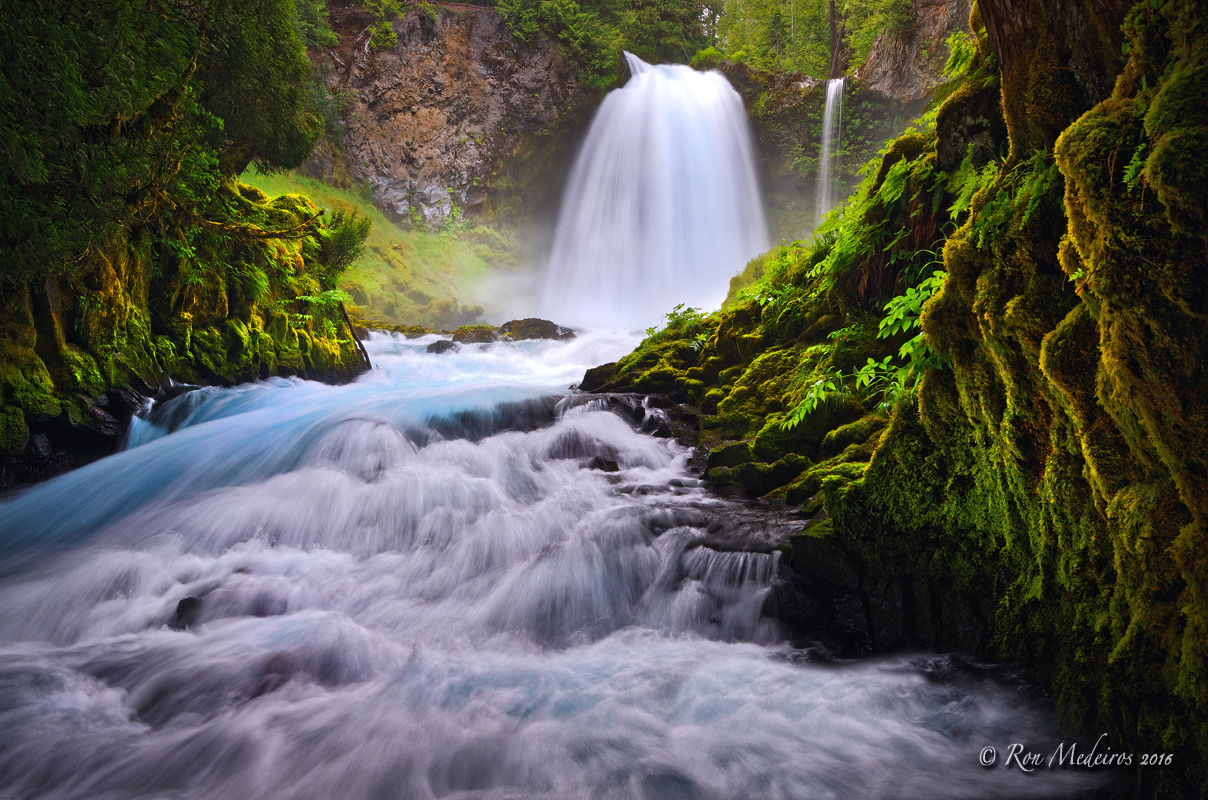
Sahalie Falls
Nikon D7000
16-85mm VR
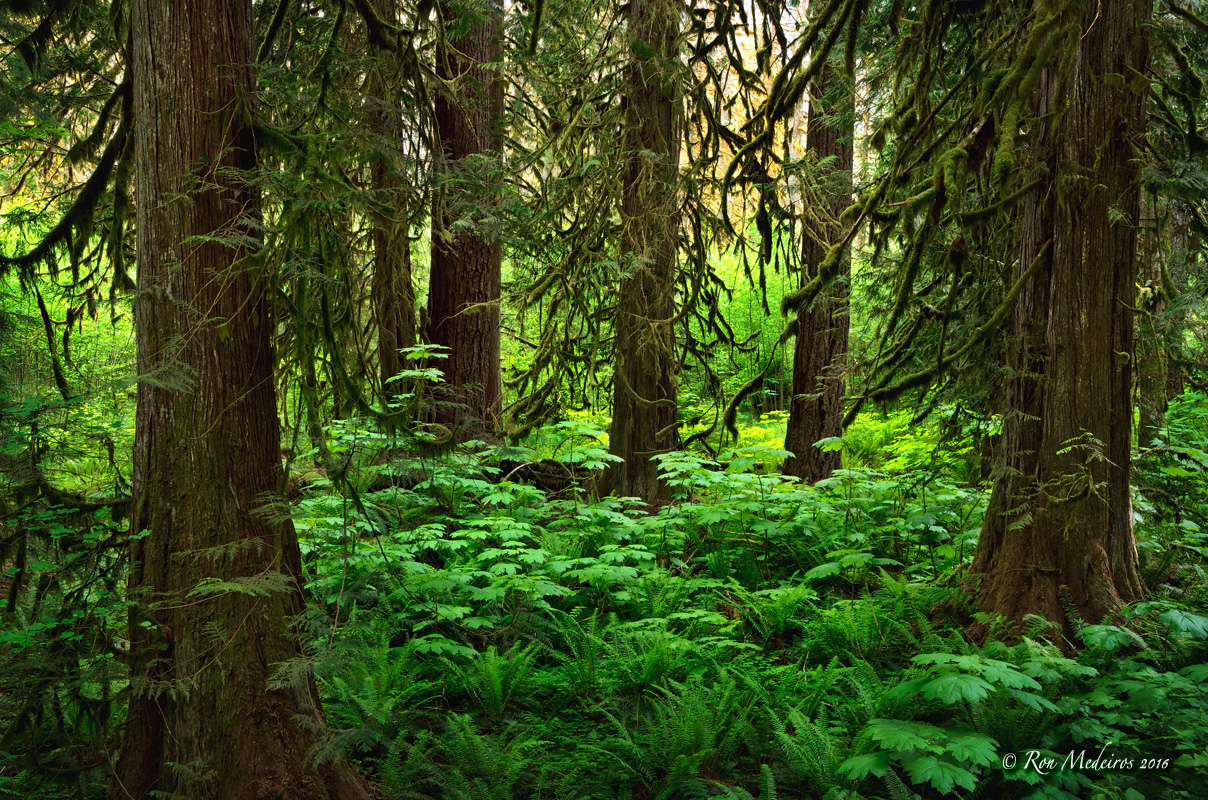
Rainier Forest
Nikon D7000
16-85mm VR
Desire and Determination
Desire: (di zire) v., 1. to want something, especially strongly.
I do not consider myself a particularly talented person. I didn't begin the journey awash with an abundance of natural photographic talent. I had to acquire and nurture the necessary skills over a very long period of time, which included most importantly of all the ability to "see" good pictures– which is the secret to creative photography. It took many years to hone these skills and I did it not so much with talent but with desire and determination and through much practice and patience. If you want something strongly enough you can usually get it through determination. One definition for the word determination that I like is: the ability to continue trying to do something, although it is very difficult.
|
| |
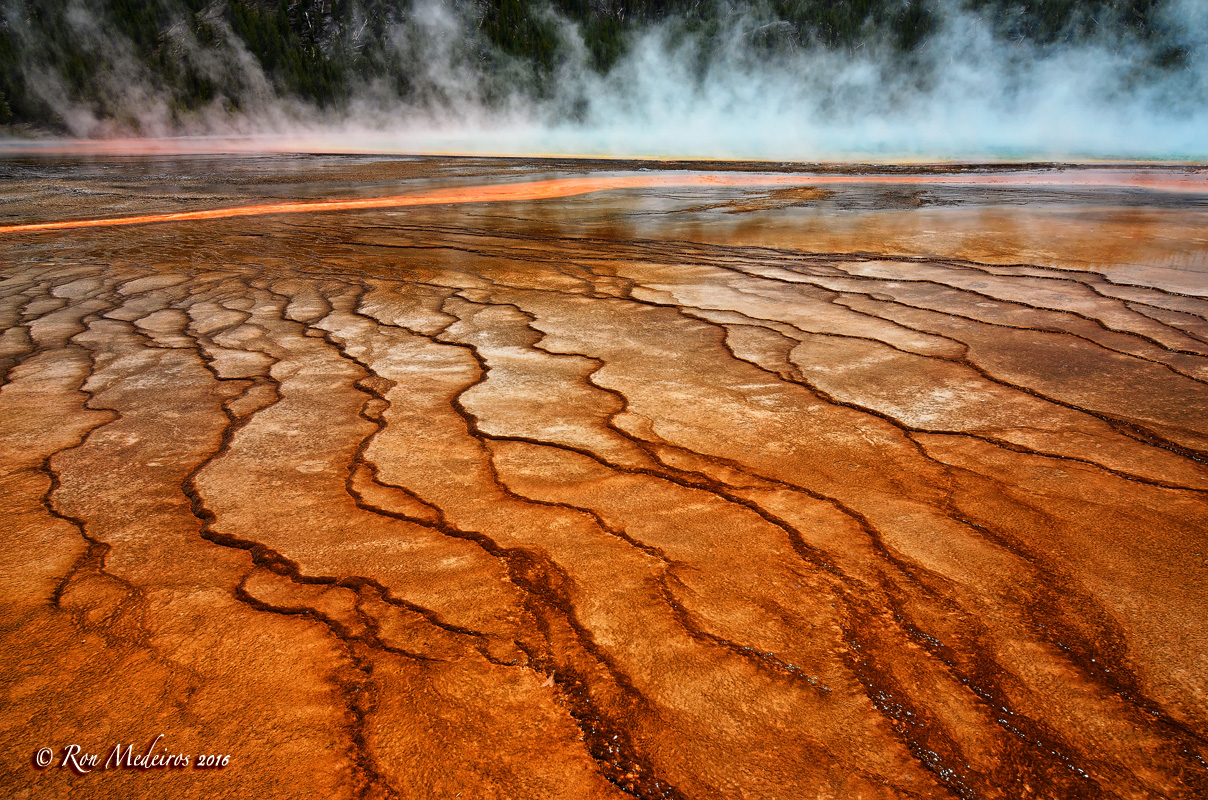
Thermophile Kingdom, Grand Prismatic Spring
Nikon D7000
16-85mm VR
Bending The Rules
Sometimes it is profitable and even necessary to bend the rules. When something is bent, care is usually taken to prevent what is being bent from being broken. This is true with regards to the rules of photographic composition. The first thing that should be understood about photographic composition is that it has rules –don't believe anyone who tells you differently. There are certain guidelines and standards that exist to make a photograph a good one. Yes, art has a strong measure of subjective liberty to it but this freedom is not without an accountability to the standards that exist within the world of art. You cannot ignore the standards that exist in art any more than you can ignore the standards of natural law. If anyone thinks that he can ignore the laws of gravity or inertia, or morality through reckless and presumptuous living he is in for a rude awakening. Imagine you are on a jet flying at 31,000 ft from Boston to L.A. One hour after takeoff you change your mind and decide to pop the hatch and walk back to your car. If you attempt such a plan you can be certain that the law of gravity is going to interrupt your plans. And pretending that gravity isn't a law is not going spare you. When a society departs from the "rules" of morality they will also depart from the standards that have existed historically in all disciplines and fields of study.
Art is not abstract. Any no talent can spit some food coloring onto a canvas, sign it, call it "art," and exhibit it in a gallery, but that doesn't make it art (even if the colors are pretty). The reason the great portrait masters of yesteryear produced such brilliant photographs was because they worked in an era of time when what made a good photograph was defined, understood, taught, and practiced. They honored the rules. Today the artistic world is too often one of abstract subjective relativism and it's no wonder seeing that most artists today are so weird – being overcome and swept away by the spirit of the age. Turn away from anyone in this world who seeks to deny the standards and refuses to play by the rules. Oftentimes, photographers will say that there are no rules to composition and then they will go on to list a number of things (rules) that make for stronger compositions. They don't want to call rules rules, but that is what they are. What is a game without rules? Can anything without rules, standards, or guidelines be consistently defined? If photography is all subjective preference than how could we know that anything is good? We see good and bad pictures all the time and the reason we can thus judge is because there are reasons (standards) why pictures are good or bad or weak or strong.
Though rules and standards are a bedrock reality it is also important to know when and how it is appropriate to bend, or to put it better, "relax" the rules. Rules are essential, but it is how you relate to the rules that is key. Relaxing the rules has more to do with relaxing the way we relate to the rules. When I began in photography I was too bound up by the rules– I related to them too rigidly focusing primarily on keeping all of them. The result was that my photographs were too static and lifeless; my pictures had no heart and soul. Over the years I have learned how to relax my use of the rules (and to even break some rules when it works) to release a great deal more creative freedom and thus make better photographs. It's not that broken rules make better pictures, but a freer creative eye does. The best place to find yourself as a seasoned photographer is to have studied and honored the rules of composition for so long that you can now consistently and effectively use them without even thinking about them. And one final note, remember that once in a while, even in spite of the rules, a good photograph is a good photograph just because it is.
|
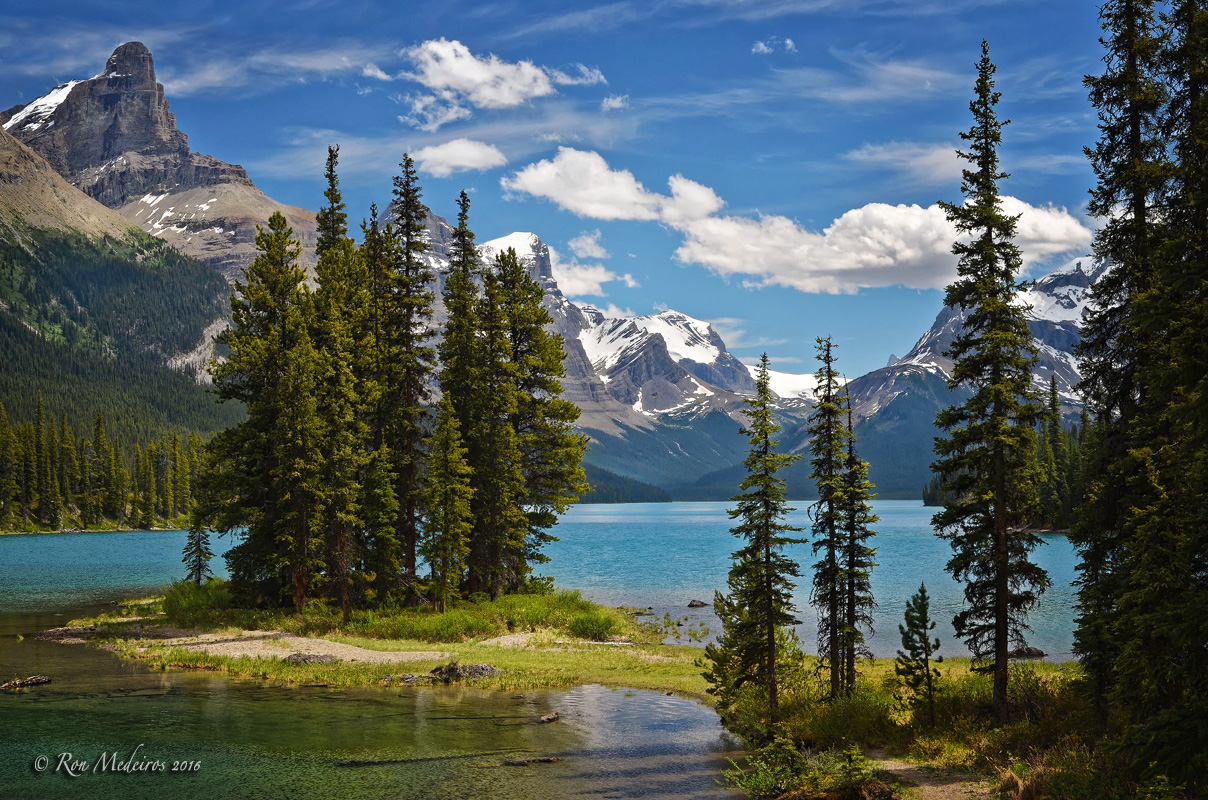
Spirit Island
Nikon D7000
16-85mm VR
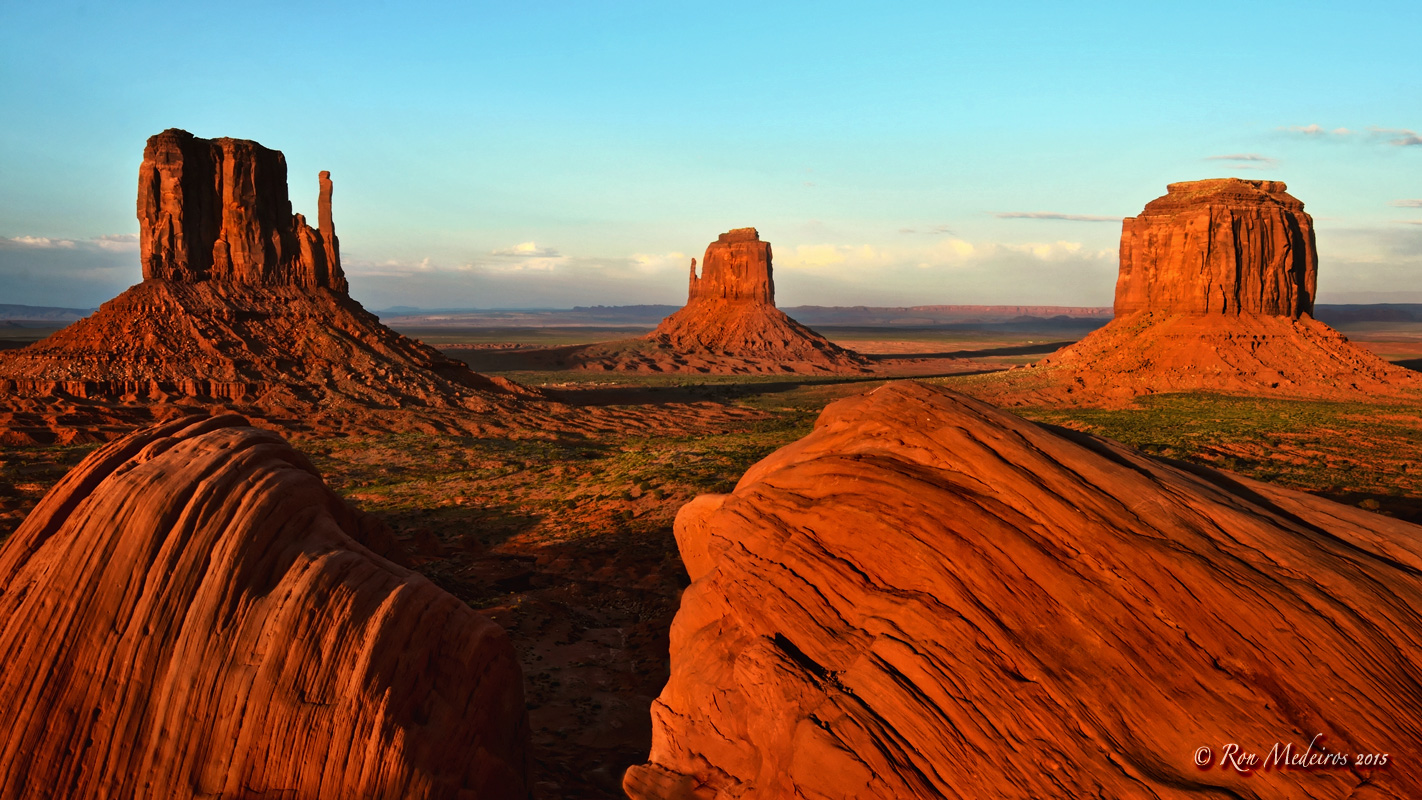
Monument Valley
Nikon D7000
16-85mm VR
A Photographer First
I am a photographer first, before anything else within the sphere of photography. I am not merely a camera buff, or camera collector, or photo blogger, or online camera reviewer. I make photographs, and the camera is just one of the means with which I do this. Don't get me wrong, I love my cameras and lenses, they are a very enjoyable part of photography. Perhaps this is what makes photographers different from other artists. A photographer loves to create his art specifically through the means of his camera. Creative photography is uniquely different, it is both an art and a science and certainly the most multi-faceted artistic medium. It consists of both creative vision and the means of mechanism.
I remember back in the beginning of my first year of photography school, when a group of students in my class rushed up to the instructors with a barrage of camera questions. One instructor put up his hands as if to shield himself and said, "we are not camera technicians, we are photographers. Cameras are simply the tools that we use to make photographs. This school is about learning how to make photographs." This has always stuck with me and I echo this sentiment.
I am not a camera collector though I do have a small collection of favorite ones. Some are practical workhorses and some more sentimental keepsakes from the past, but all are shooters and not merely collector's pieces that stay on the shelf. I am not a camera reviewer either, it doesn't suit me. If I were to give my time to such an endeavor then I would be less inclined to making the best photographs possible. Camera reviewers are people who review the latest cameras and lenses and offer how to tutorials with the hopes of drawing traffic to their website. The idea is to constantly put the latest and greatest gear in front of people so that they will purchase a product through their link in order to make a percentage of the sale. That's OK, I guess, but it's just not something I want my life to be about. I am a photographer first.
And lastly, I do not refer to myself as a professional. This basically means that what motivates me to make photographs is love and not profit. Why take the joy out of photography by making it my Job? For me photography is about being free to make the pictures I want to make and creating a body of work that will outlive my earning a living. Comparatively, there are far fewer people who earn a good living with their photography. Many of the well known photographers of the past went broke creating their body of work and when we admire their work today the pictures themselves are all that matters. No one ever asks, "how much did he make off of that picture?"
|

Balance Rock
Nikon D7000
16-85mm VR
A Window To Another Place
A good landscape photograph should look very much like an open window to another place. This is how I like to render my landscapes, as real as if we are standing there in person. Not merely an artistic rendering or impression of some possible place, but an open window that transports the beholder to an actual place. A place that is as big as life with a three dimensional quality of realism, that for a moment makes us forget where we are presently. |
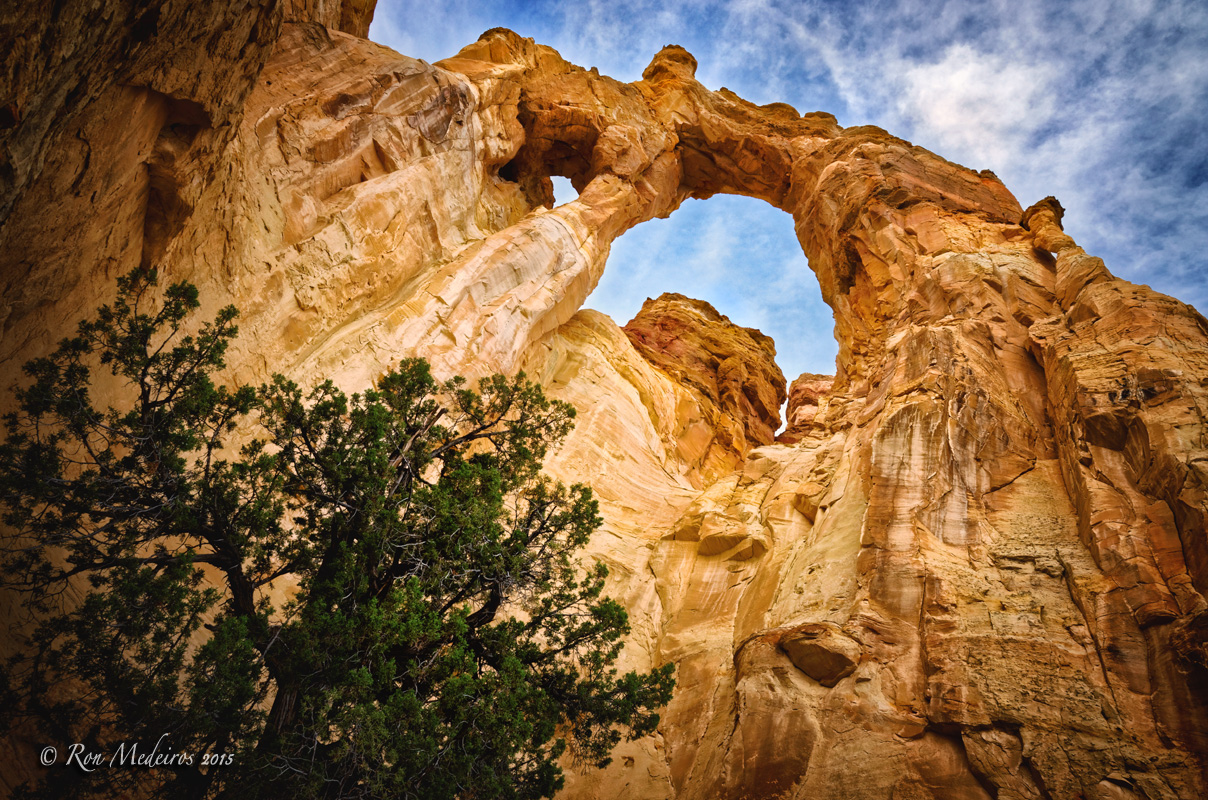
Grosvenor Arch, Grand Staircase-Escalante National Monument
Nikon D7000
16-85mm VR
A True Amateur
I consider myself to be a true amateur photographer, and it is a badge I wear proudly. The word amateur is from the Latin verb, "to love" (amo, amas, amat) and it's original meaning has to do with motivation and not quality. "Amateur" does not mean, inferior to professional. An "amateur" is a person who does a thing simply for the love of it – and it is desire that best fuels excellence. A "professional" photographer is motivated primarily by profit and is often driven by a need to be successful. The amateur, on the other hand, is motivated purely by his love for photography, and is therefore already successful. As an amateur photographer I am free to make the pictures I want to make and to produce a body of work that defines who I am as a photographer. The definition of a photographer may be as simple as, "one who makes photographs." This is how I think of myself.
|
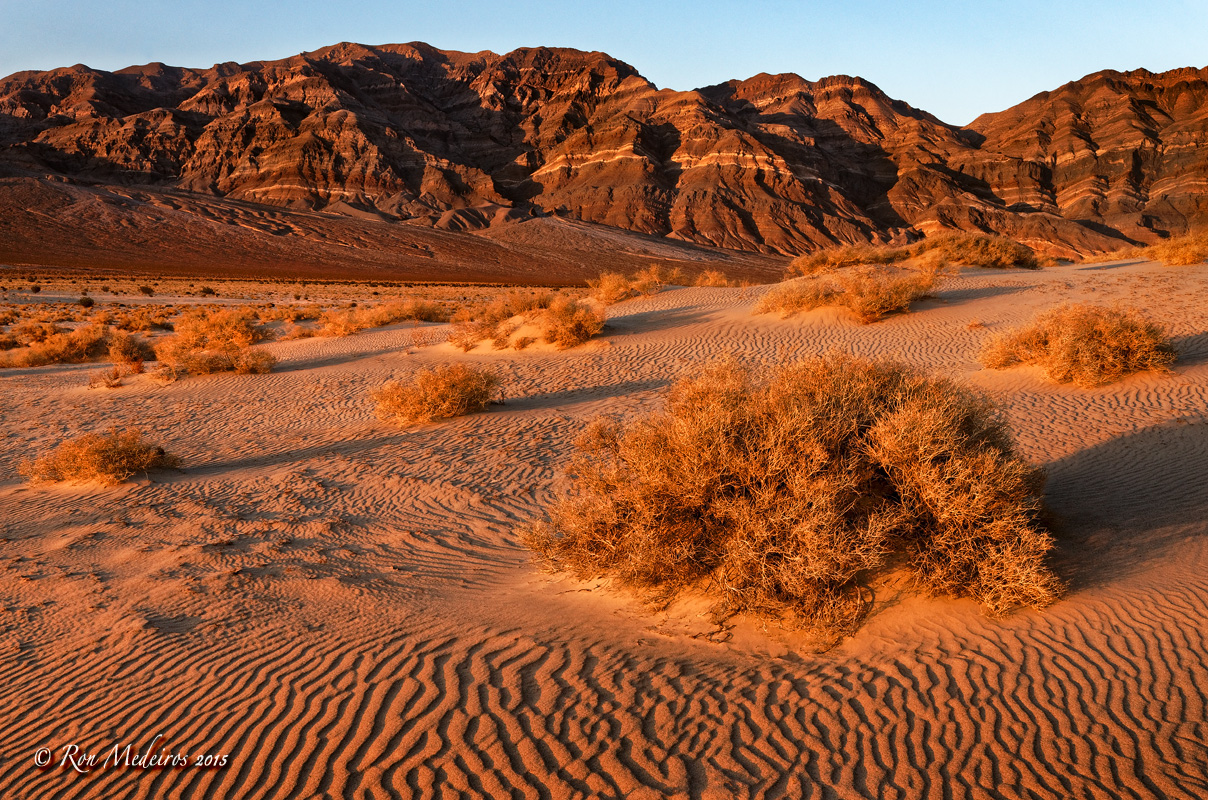
Eureka Gold
Nikon D7000
16-85mm VR
Silence Is Golden
One of the best compliments a photographer can get, as a response from those who observe his work, is no response at all. In this regard, “silence” is golden. This kind of silence isn't silent at all, but speaks volumes, and is much louder than applause. You know with certainty that your work has really struck a cord and made an impression when it is followed by deafening silence. The cricket’s chirp is often the surest applause. Let this be your encouragement as an artist in pursuit of masterpiece excellence within an envious and competitive world.
Spoken accolades are only for the famous, and for those whose names are of use to the one’s who laud them. But those whose names have nothing to offer are better left in the state of disregard where they are no threat to anyone’s self image, reputation, or following.
Silence is safer than criticism because a critic who finds fault may call into question his own judgement. His silence, on the other hand, can more safely work to conceal and diminish the value of a rival’s work. A photograph that is truly masterful cannot be faulted with any credibility on the part of the critic, so he is left only with the option of remaining silent about it in the hopes that no one else will notice it.
A really good photograph should have good composition, good light, and either a great deal of impact or else a sense of moment. Whenever I pull this off in a really big way it is sure to shut mouths. As a photographer, I know I've really done my job and created a dynamic photograph when it is followed, for the most part, by silence.
I have always believed in lending credit where credit is due, and have been quite generous in this regard. A concert pianist, at the end of his performance, receives a fitting ovation – an acknowledgement of his years of practice and dedication to excellence. It would be ridiculous and even insulting for the audience to instead quietly get up from their seats and leave. But envy is a rude spectator and often goes mute in the presence of superiority. Accolades are like currency and most people would rather rake it in rather than pay it out. Most are looking to get rich themselves and lending credit where credit is due doesn't serve that end.
I have learned to enjoy that oh so sweet and rewarding sound of silence. It is enough to know that I have accomplished my objective and that it is apparent to the beholder. For after all is said and done what are accolades? Accolades cannot make a man or his work great, they can only call attention to that fact that a man and his work are already intrinsically good, but silence does it better. |
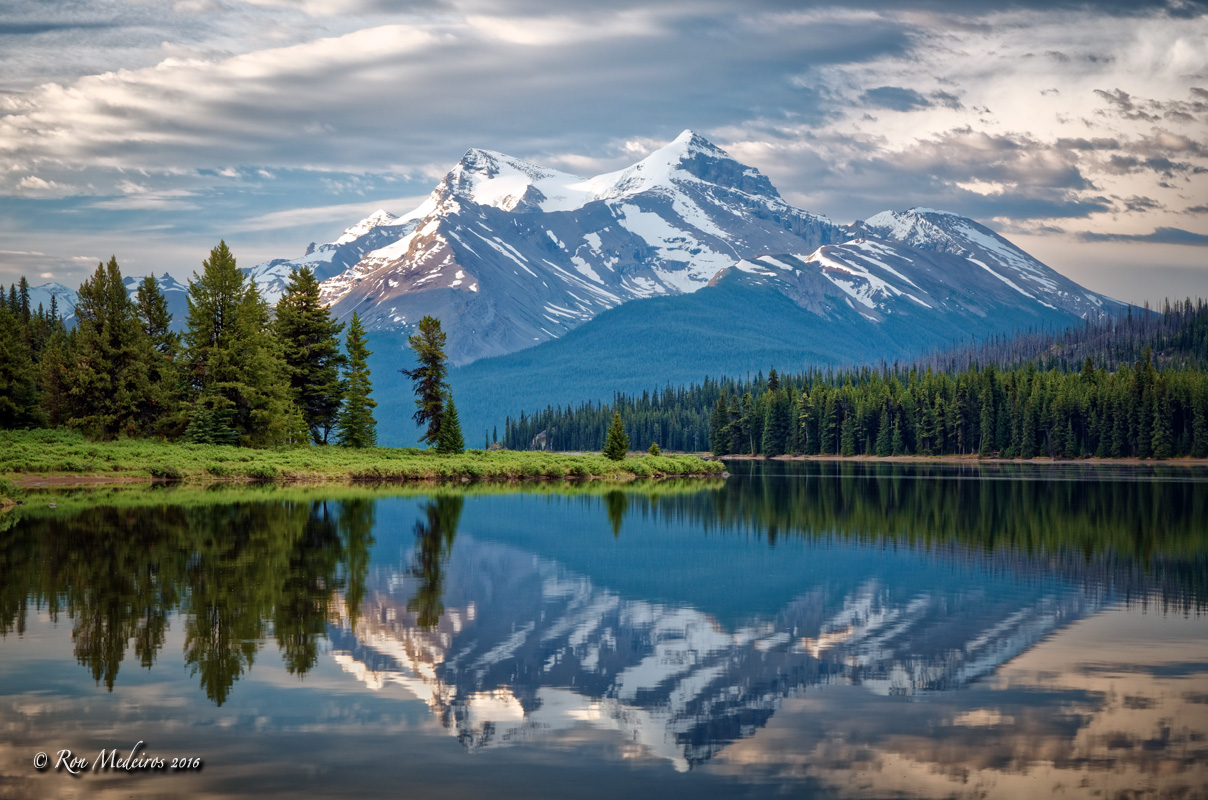
Maligne Lake Morning
Nikon D7000
16-85mm VR

Mount Rundle
Nikon D7000
16-85mm VR
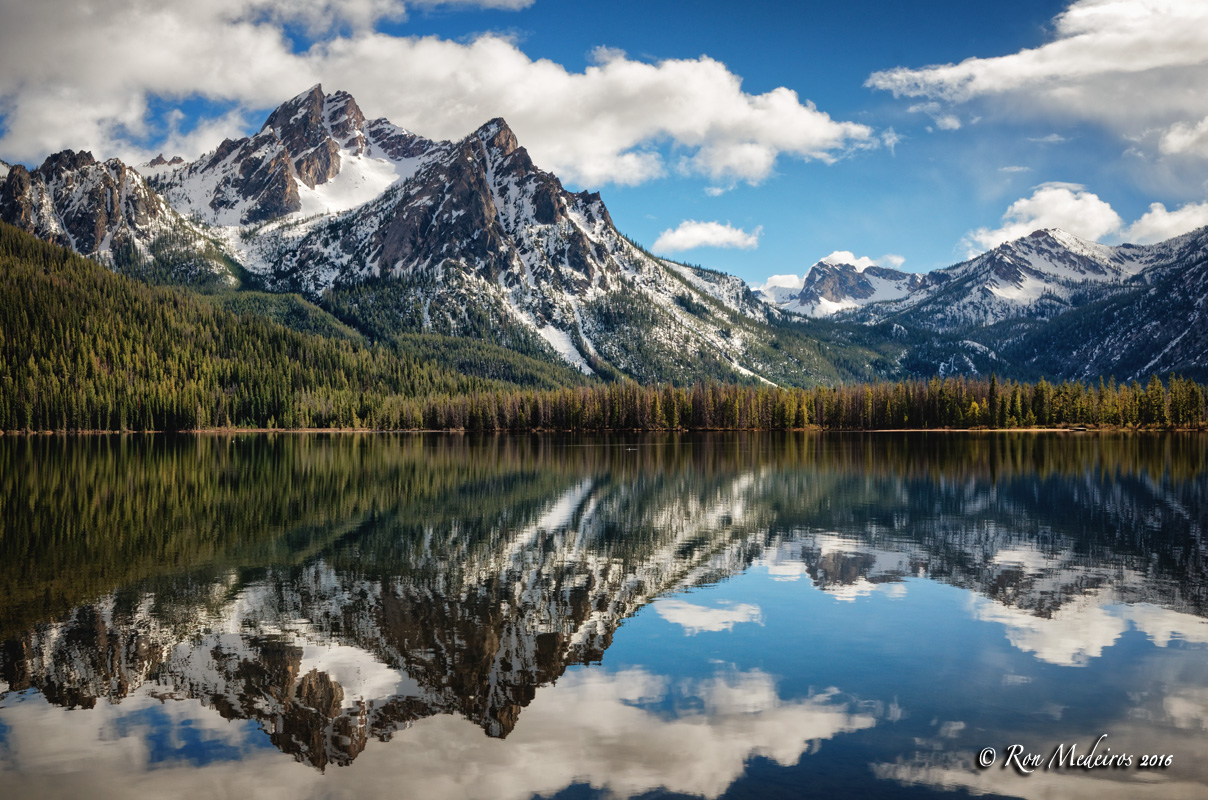
McGown Peak From Stanley Lake
Nikon D7000
16-85mm VR
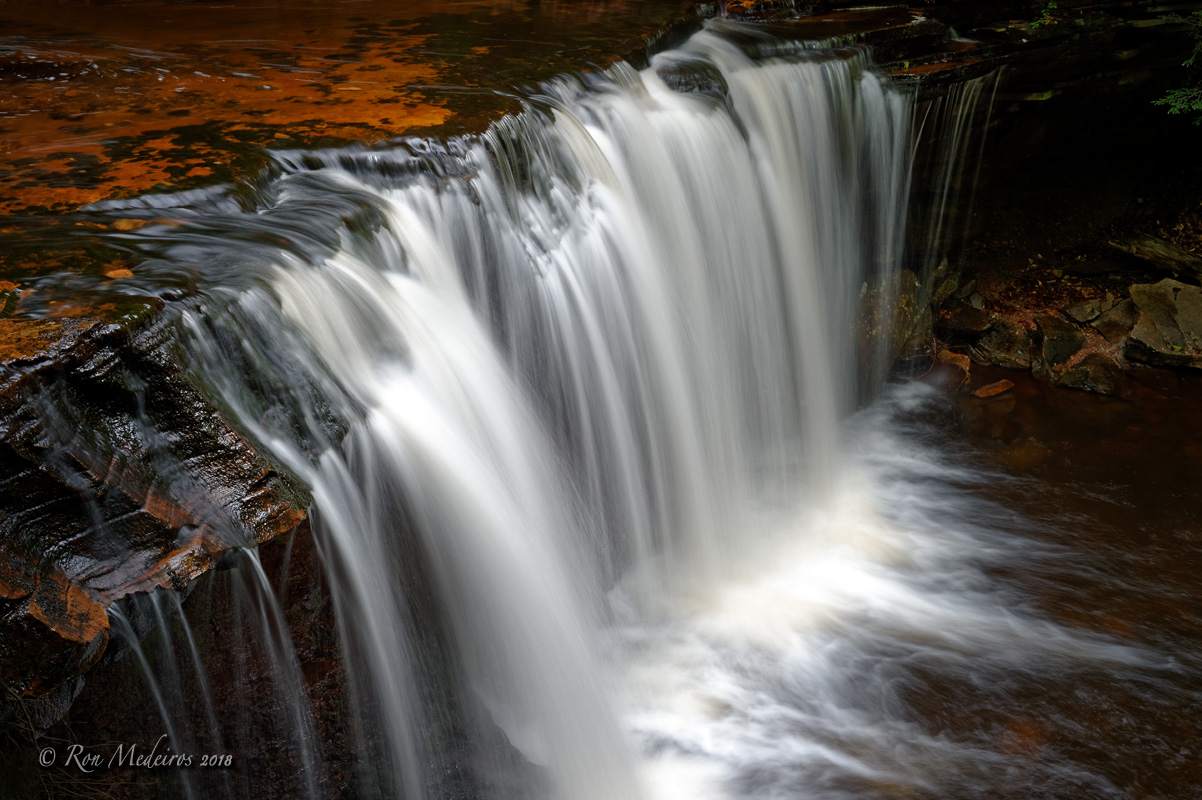
Oneida Falls
Nikon Df
24-85mm AF-S G
Perpetuity
For some it is enough to accomplish some goal or life's dream and then sit back and admire it like a trophy in a glass case. It is like a past completed action. I, on the other hand, crave the continuous on going action of living my dream perpetually. It is not enough for me to have done something; I want to do it for the duration and beyond into the forever. I want perpetuity.
Why are there always cobwebs – even in king's palaces? It is because the spiders never stop spinning. Why is the earth filled with honey? It is because the bees never stop foraging. And why is there food in an anthill? It is because the ants are relentless gatherers. These things they all do perpetually.
Each photograph that I make brings me a sense of accomplishment and great pleasure, but there is always the next one that must be made, not out of need but out of endless desire and delight. Give me the full ongoing experience and not just the ultimate effect. Let my photography be a perpetual motion. Give me a life of photography or no photography at all. Don't give me a mere taste or even a single great banquet, but let me eat freely for all my days and beyond. Give me perpetuity! |
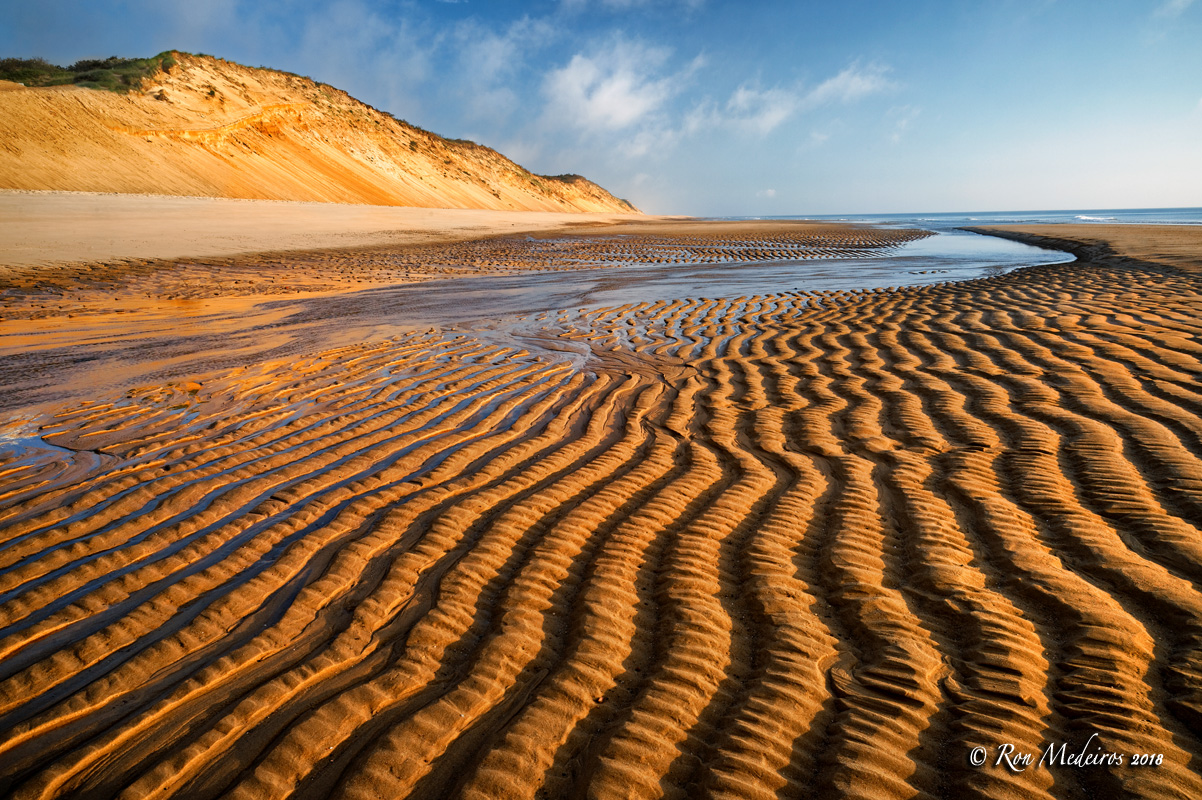
Cahoon Hollow Sands, Cape Cod National Seashore
Nikon Df
24-85mm AF-S G
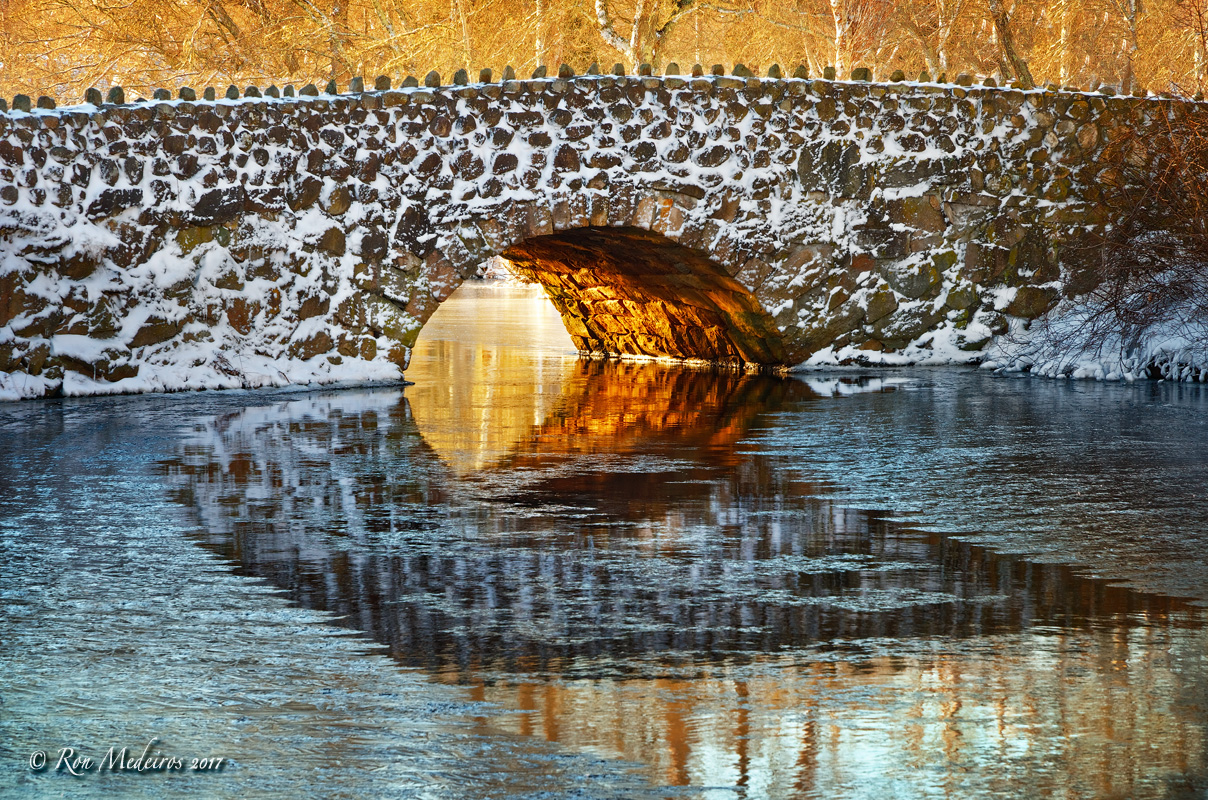
Arch Bridge, Mattapoisett River, Winter
Nikon D7000
18-70mm AF-S G
Serendipity
Serendipity: (sĕr″ən-dĭp′ĭ-tē ) n. 1. The faculty or phenomenon of finding valuable or agreeable things not sought for.
Serendipity– that wonderfully mysterious and unpredictable enabler of photographic opportunity. You can't control it or conjure it up; you can only go out with your camera hoping to find it waiting for you in the right time and place when providence favors a prepared eye. Sometimes great photographs "happen" when serendipity and creative perception meet together. (See Little Cowgirl) which was an example of opportunity and active preparedness that converged upon a sudden moment. I was walking through the horse stables at the Maryland State Fair when I happened upon this little girl sitting in her folding chair eating Cheetos. It all happened in a matter of seconds. I asked her mother If I could take her picture, "sure," she replied. As I was framing up the shot, her mother said, "wait, get one with her cowboy hat" and she placed the hat on her head. I made the shot, thanked them, and moved on. Serendipity! This shot could easily have never been made or been much less than it is if I had not been paying attention, or If I failed to act, or if the girl and her mother were not in place in that moment. Sometimes great photographs just "happen" when you get out with your camera.
The photograph above of the Arch Bridge in my hometown of Mattapoisett is another example of finding something unexpected. I made this image the morning after a blizzard in January of 2017. It is difficult to make a good photograph of the north side of this bridge as it is always in shade and usually renders dull and drab. I was fortunate to find the north side of the bridge coated with snow blown onto it over night by strong winds. The element of the snow along with the warm backlight from the sun adds a great deal of contrast and a strong wintery feeling to this scenic rendering of one of Mattapoisett's historical landmarks. I had not anticipated this wonderful surprise that made the morning shoot a successful one. I thank God who is the Lord of sweet serendipity for his special gift. |
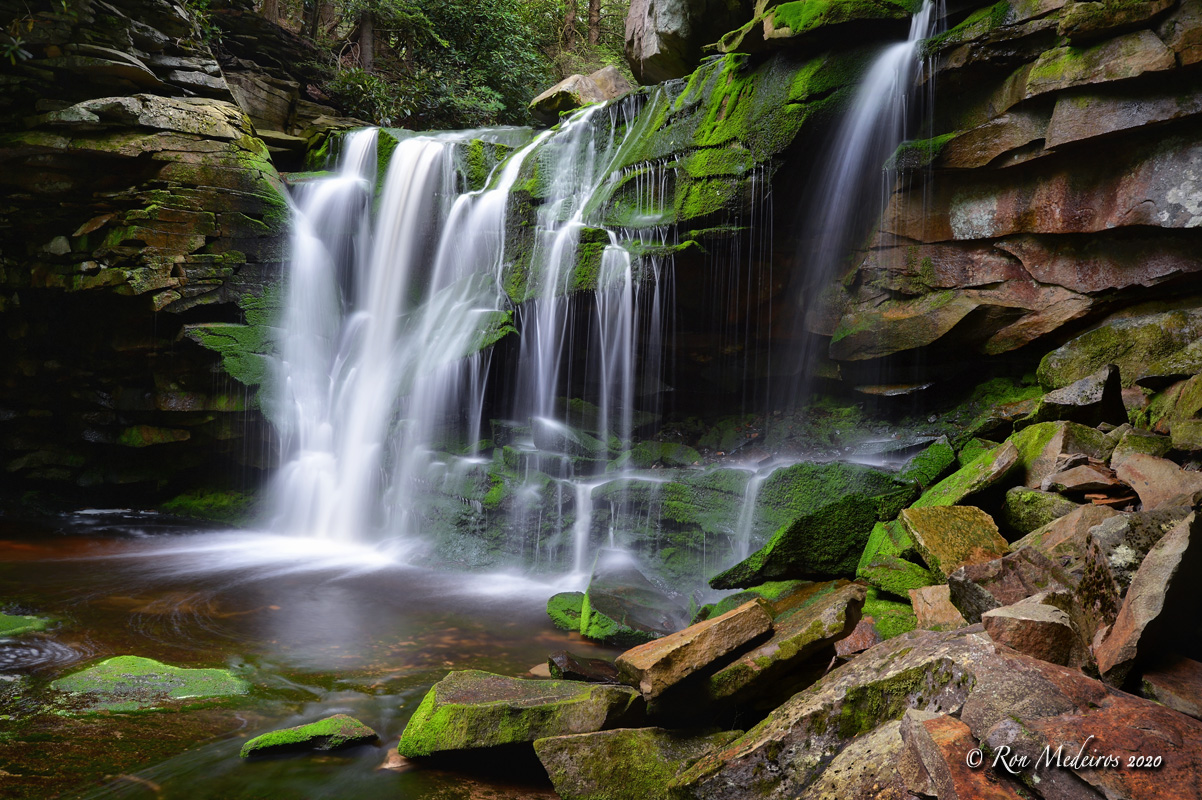
Elakala Falls
Nikon Df
24-85mm AF-S G
Signature Rendering
I had to add this photograph of what has become one of my favorite waterfalls. I just love this rendering in this stage of flow. Many people have made photographs of Elakala with the pool of spiraling foam in the foreground which has been overdone to the point of becoming "cliche." I find this composition to be more original. Just as everyone's signature is uniquely different so are the renderings of every individual photographer. This is my "signature" rendering of Elakala as if I had photographed it having discovered it for the first time. |
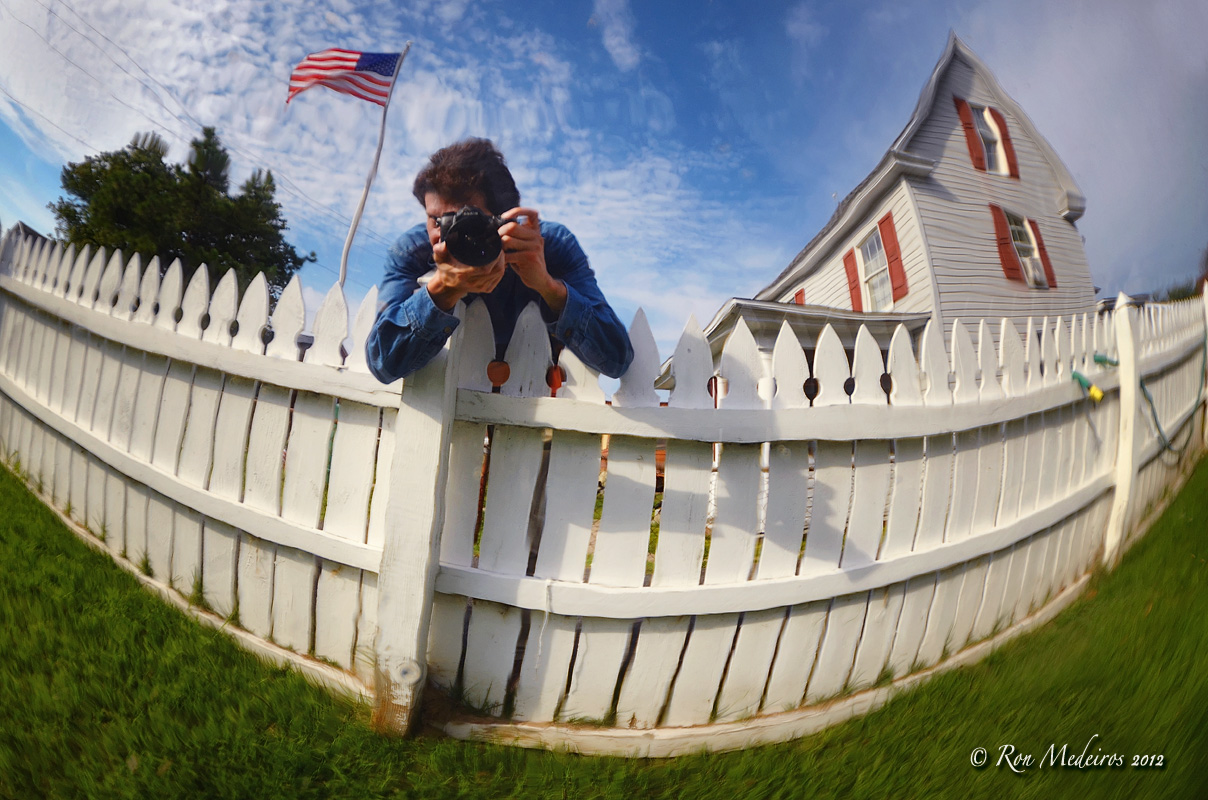
In The Gazing Ball, Self-Portrait
Nikon D7000
18-200mm VR
|





































